(Compiled by Jamyang Norbu for the Rangzen Alliance)
.
This is a considerably revised and expanded version of the document, Losar Gift for Rangzen Activists, that I posted on Feb 25, 2009. This version has new information and illustrations. Last year when I was in India I gave a talk and powerpoint presentation based on this essay at a number of Tibetan schools and centers. I am happy to report that everyone was uplifted and energized by the sheer volume of indisputable facts substantiating Tibetan independence. It may have hit a sore spot in Beijing, though, for I was denounced at length on bbs.tibet.cn for this specific presentation. In order to ensure’s Beijing’s continued “sensitivity” on the issue of Tibetan independence, a Chinese translation (in traditional as well as simplified script) will be up on lovetibet.ti-da.net, and other sites thanks to freedom activist Rosaceae. A full Tibetan translation will be at www.khabdha.org, and also be published in Tibet Times, all thanks to Gedun Rabsal la. You can also go on rangzen.net for the translations and for downloading print-ready pdf files to make flyers. I would like to thank all organizations that printed and distributed flyers last year, and would encourage them and others to do so again this year on March 10th and other occasions. Feel free to contact me for questions or suggestions.
* * *
FUNCTIONING STATE
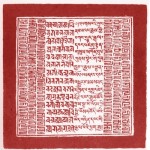 Tibet was a fully functioning and independent state before the Chinese invasion. It threatened none of its neighbors, fed its population unfailingly, year after year, with no help from the outside world, and owed nothing to any country or international institution. Although insular, theocratic and not a modern democracy, Tibet maintained law and order within its borders and conscientiously observed treaties and conventions entered into with other nations. It was one of the earliest countries to enact laws to protect wildlife and the environment – recurrently cited in the “Mountain Valley Edicts” issued since 1642 [1], and possibly earlier. [2]
Tibet was a fully functioning and independent state before the Chinese invasion. It threatened none of its neighbors, fed its population unfailingly, year after year, with no help from the outside world, and owed nothing to any country or international institution. Although insular, theocratic and not a modern democracy, Tibet maintained law and order within its borders and conscientiously observed treaties and conventions entered into with other nations. It was one of the earliest countries to enact laws to protect wildlife and the environment – recurrently cited in the “Mountain Valley Edicts” issued since 1642 [1], and possibly earlier. [2]
Tibet abolished capital punishment in 1913 (noted by many foreign travelers [3]) and was one of the first nations in the world to do so. There is no record of it persecuting minorities (e.g. Muslims [4]) or massacring sections of its population from time to time as China (remember Tiananmen) still does. Although Tibet’s frontiers with India, Nepal and Bhutan were completely unguarded and Tibetans were “great travelers” [5] , very few Tibetans fled their country as economic or political refugees. There was not a single Tibetan immigrant in the USA or Europe before the Communist invasion.
* * *
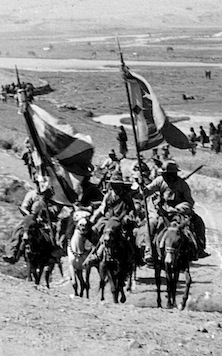
Tibetan soldiers with national flags
FOREIGN MILITARY INVASION NOT “PEACEFUL LIBERATION”
On the dawn of 5th October 1950, the 52nd, 53rd & 54th divisions of the 18th Army [6] of the Red Army (probably over 40,000 troops) attacked all along the cease-fire line (mentsam-shagsa) on the Drichu River guarded by 3,500 regular soldiers and 2,000 Khampa militiamen. Earlier, in late 1949, Communist forces had entered areas of Eastern (Kham) and North-Eastern Tibet (Amdo) then under the military occupation of Nationalist (Guomindang) supported war-lord regimes. Recent research by a Chinese scholar reveals that Mao Zedong met Stalin on 22nd January 1950 and asked for the Soviet air force to transport supplies for the invasion of Tibet. Stalin replied: “It’s good you are preparing to attack Tibet. The Tibetans need to be subdued.” [7]
An English radio operator Robert Ford (in Tibetan government service) at the Chamdo front wrote that Tibetan forward defenses at the main ferry point on the Drichu River fought almost to the last man. [8] In the south, at the river crossing near Markham, the frontline troops fought heroically but were wiped out, according to an English missionary eye-witness. [9] Surviving units conducted fighting retreats westwards. Four days into the retreat, one regiment was overwhelmed and destroyed. Two weeks after the initial attack, the Tibetan army finally surrendered. The biography of a Communist official states “Many Tibetans were killed and wounded in the Chamdo campaign.” and “… the Tibetan soldiers fought bravely, but they were no match for the superior numbers and better training” [10] of the Chinese forces. According to the only Western military expert who wrote on the Chinese invasion of Tibet “…the Reds suffered at least 10,000 casualties.” [11] One regiment of the Red army attacked from Xinjiang, but, in an account by a Chinese soldier [12], the advance guard was held back, to a near standstill, by the nomadic militia of Gertse in Ngari (Western Tibet). This soldier also writes that the Red Army leadership could find no Chinese maps of the region to plan their invasion, and eventually had to use one published in British-India.
In 1956 the Great Khampa Uprising started and spread throughout the country culminating in the March Uprising of 1959. Guerilla operations only ceased in 1974. “A conservative estimate would have to be no less than half-a-million” [13] Tibetans killed in the fighting. Many more died in the subsequent political campaigns, forced labor camps (laogai) and the great famine. The revolutionary uprisings throughout Tibet from 1987 to 1990 and most recently in 2008 –followed by draconian Chinese reprisals – clearly demonstrate that the struggle continues today.
* * *
NATIONAL FLAG

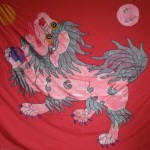 The modern Tibetan national flag was adopted in 1916. [14] Its international debut was in the National Geographic Magazine’s “Flags of the World” issue of 1934. [15] It even featured in a cigarette-card [16] series in Europe in 1933. The flag was probably too new to appear in the very first flag issue (1917) of the National Geographic, but Tibet does receive mention in an article on medieval flags in that same issue. [17] According to an eminent vexillologist, Professor Pierre Lux-Worm, the national flag of Tibet was based on an older 7th century snow lion standard of the Tibetan Emperor, Songtsen Gampo. [18] It should be borne in mind that over 90% of the flags of the nations in the UNO were created after WWII, including the national flag of China. The Tibetan flag made its official international appearance in 1947, at the First Inter-Asian Conference, which Mahatma Gandhi addressed. The Tibetan flag was displayed alongside other flags of Asian nations, and a circular flag emblem placed before the Tibetan delegation on the podium. [19]
The modern Tibetan national flag was adopted in 1916. [14] Its international debut was in the National Geographic Magazine’s “Flags of the World” issue of 1934. [15] It even featured in a cigarette-card [16] series in Europe in 1933. The flag was probably too new to appear in the very first flag issue (1917) of the National Geographic, but Tibet does receive mention in an article on medieval flags in that same issue. [17] According to an eminent vexillologist, Professor Pierre Lux-Worm, the national flag of Tibet was based on an older 7th century snow lion standard of the Tibetan Emperor, Songtsen Gampo. [18] It should be borne in mind that over 90% of the flags of the nations in the UNO were created after WWII, including the national flag of China. The Tibetan flag made its official international appearance in 1947, at the First Inter-Asian Conference, which Mahatma Gandhi addressed. The Tibetan flag was displayed alongside other flags of Asian nations, and a circular flag emblem placed before the Tibetan delegation on the podium. [19]
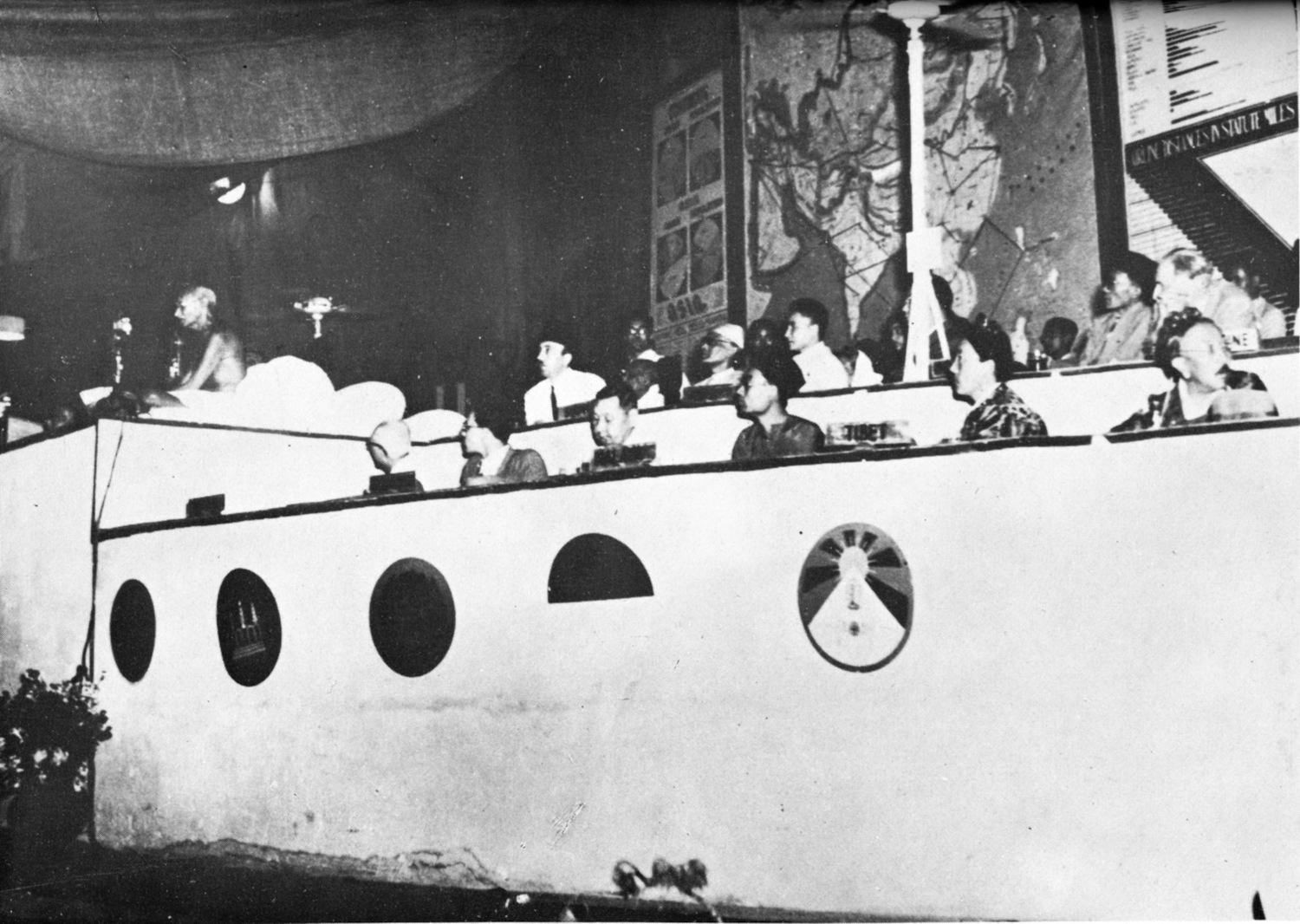
First Inter-Asian Conference, Delhi, 1947.
* * *
NATIONAL ANTHEM
The old Tibetan national anthem or national hymn, Gangri Rawae or “Snow Mountain Ramparts” [20] was composed in 1745 by the (secular) Tibetan ruler Pholanas. [21] It was recited at the end of official ceremonies and sung at the beginning of opera performances in Lhasa. [22]
[audio:Gangri_Rawai_2_Fn_mix_128kbps.mp3]When the Tibetan government came into exile in India, a more modern national anthem, Sishe Pende [23] (“Universal Peace and Benefits”) was adopted. The lyrics were composed by the Dalai Lama’s tutor, Trichang Rimpoche, who was considered a great poet in the classical nyengak (Skt. kaviya) tradititon.
* * *
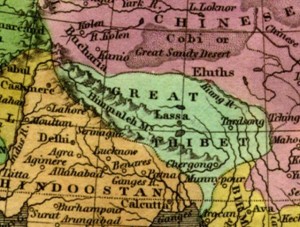
Detail from 1827 map
MAPS OF TIBET
Most pre-1950 maps, globes and atlases, including the earliest maps on record of Asia, depict Tibet as an independent nation, separate from China. Tibet is variously referred to as Tobbat, Thibbet or Barantola. A map of Asia drawn by the Dutch cartographer, Pietar van der Aa around 1680 shows Tibet in two parts but distinct from China; [24] as does a 1700 map drawn by the French cartographer Guillaume de L’isle, where Tibet is referred to as the “Kingdom of Grand Tibet.” [25] A map of India, China and Tibet published in the USA in 1877 represents Tibet as distinct from the two other nations. [26] An 1827 map of Asia drawn by Anthony Finley of Philadelphia, clearly shows “Great Thibet” as distinct from the Chinese Empire. [27]
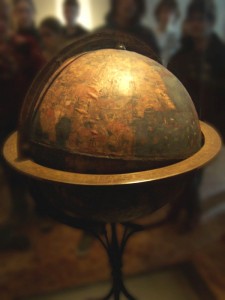
Martin Behaim’s globe at Nuremburg
The oldest existing globe in the world, and possibly the first terrestrial globe ever made, was constructed by Martin Behaim (geographer to the king of Portugal) in 1492. It depicts the world before the discovery of the Americas. Tibet is clearly identified in German as “Thebet ein konigreich”, or “Tibet, a kingdom”. [28]
The largest stained glass globe in the world (in Boston), based on the Rand McNally 1934 map of the world, shows Tibet as a separate nation. [29]

The “Mapparium” in Boston, MA.
Early Chinese maps do not feature Tibet as a part of China. In a landmark map of China [30] drawn in 1594 by Wang Fen (or Wang Pan?) , a senior Ming Legal Officer, there is a note stating that the map included the whole of China’s territory. But no Tibetan areas, not even the eastern-most regions of Amdo or Kham, appear on the map.
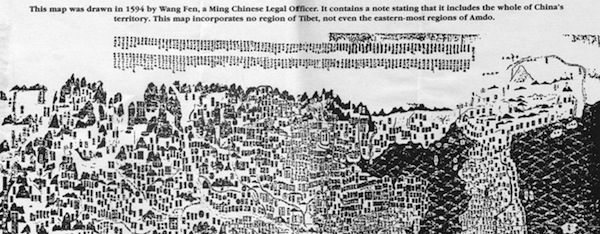
Upper section of 1594 Ming Map
Following the publication of the atlas commissioned by the Manchu Emperor Kangxi and created by French Jesuit cartographers, some Chinese and European maps begin to depict Tibet as a colony or protectorate of China. The Jesuits could not personally survey Tibet (as they had surveyed China and Manchuria), since Tibet was not part of the Chinese Empire. So they trained two Mongol monks [31] in Beijing and sent them to make a secret survey of Tibet. Similar clandestine surveys of Tibet were conducted by British mapmakers using trained Himalayan natives and even a Mongol monk. An American sinologist, writing on such issues, notes that, like European colonial powers, China used cartography to further its “Colonial Enterprise” in Tibet and Korea. [32]
* * *
TIBETAN CURRENCY
Literary sources [33] refer to gold, silver and copper ingot-coins, even cowrie shells, being used as currency in ancient Tibet. From circa 1650 silver coins for Tibet (the Bhal-tang) were struck in Nepal under a treaty agreement. [34] In 1792 following the defeat of Nepal by a joint Tibetan-Manchu force, coins bearing both Tibetan and Chinese inscriptions were circulated. But the Tibetan government continued to issue its own coin with only Tibetan legends as the Kongpar tangka (1791-93) and the Gaden tangka (1836-1911). A silver coin, the Kalsang tangka, was struck in 1909 possibly to mark the 13th Dalai Lama’s return to Lhasa from Peking.

Kongpar tangka, Gaden tangka, Kalsang tangka and three Srang coin
After the expulsion of the Chinese army in 1912, Tibet minted gold, silver and copper coins (in the “srang” currency unit) using Buddhist and Tibetan designs and bearing the name of the Tibetan government. Paper currency was introduced into Tibet in the early 20th century, and according to the numismatist Wolfgang Bertsch, these bank notes were “small works of art.” [35] A unique aspect of Tibetan banknotes was that the serial numbers were handwritten by a guild of specialist calligraphists, the “epa”, to prevent forgery.
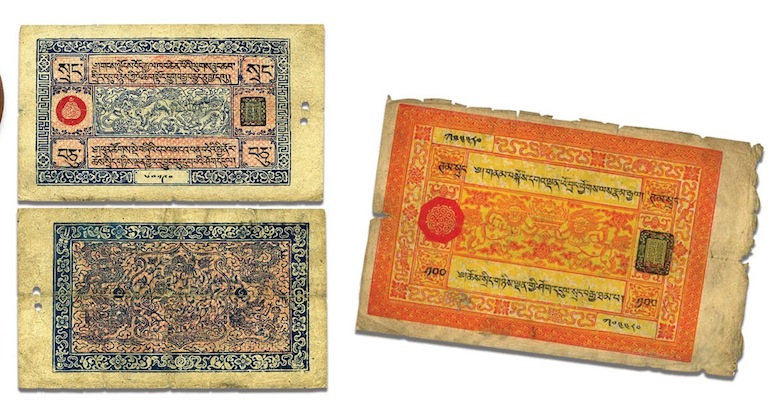
Even after the Communist invasion, Tibetans successfully resisted Chinese efforts to take over its currency. Official Chinese currency only came into use after the flight of the Dalai Lama and the Tibetan government from Tibet in March 1959. [36] In its entire history, official Chinese currency had never been used in Tibet before 1959.
* * *
TIBETAN PASSPORTS
The Tibetan government issued its own passports to travelers entering its borders or (the few) Tibetans who traveled abroad. Before WWII, the term “passport” covered visas and travel documents in general. The earliest record of a Tibetan passport issued to a foreign traveler is in 1688 to an Armenian merchant, Hovannes (Johannes). [37] In 1780 a passport was issued from Lhasa [38] to Purangir Gossain, an emissary of the Governor-General of India, Warren Hastings, who hoped to open up Tibet to trade with the East India Company.
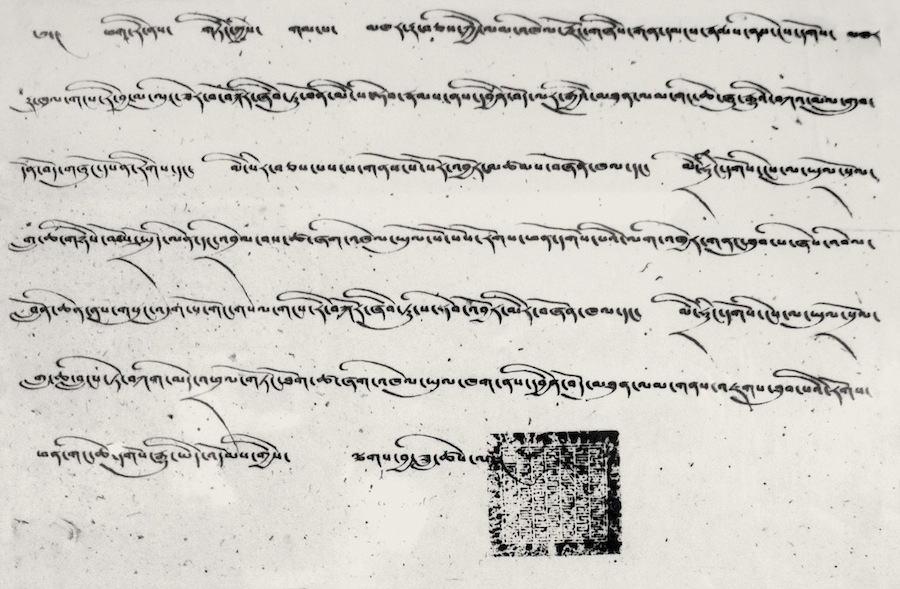
Passport issued to first Everest Expedition, 1921 (courtesy of Rinchen Dorjay).
The Tibetan government gave its approval for the first-ever Everest expedition in 1921. Charles Bell, the visiting British diplomat in Lhasa wrote “I received from the Tibetan Government a passport in official form, which granted permission for the climbing of Mount Everest.” [39] The subsequent Everest expeditions of 1924 and 1936 [40] also received passports from the Tibetan government. Passports were sometimes issued for scientific undertakings: the Schaeffer anthropological expedition of 1939, [41] Tucci’s ethnological expedition of 1949 [42] and the plant hunter Frank Kingdon Ward in 1924. [43]
President Roosevelt’s two envoys to Tibet in 1942 were presented their passports at Yatung. [44] The Americans Lowell Thomas Jr. and Sr. visited Tibet in 1949, and were issued “Tibetan passports” at Dromo. “When the Dalai Lama’s passport was spread out before us, I could not help thinking that many Western explorers who had failed to reach Lhasa would have highly prized a document like this.” [45]
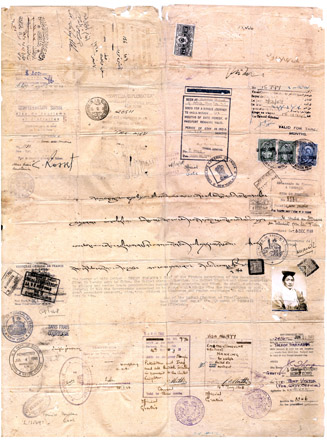
Shakabpa passport
Since 1912 passports were also issued to Tibetans leaving for foreign countries. [46] The first modern Tibetan passport [47] with personal information, photograph and space for visas and endorsements was issued in 1948 to members of the Tibetan trade mission. It was modeled on the international one-page fold-out model of 1915. Britain, the USA and seven other countries issued visas and transit visas for this document.
* * *
TREATIES
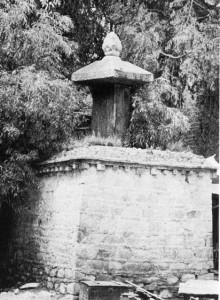
Treaty Pillar of 821-22 AD
One of the most important treaties between the Tibetan Empire and the Chinese Empire (concluded after a decisive Tibetan military victory) dates back to AD 821-822. The text, in Tibetan and Chinese was engraved on three stone pillars (doring). The only surviving pillar is near the Jokhang temple in Lhasa. [48] One clause affirms that between the two nations “…the very world ‘enemy’ shall not be spoken”. Another article regarding the frontier (near the present Gansu-Shaanxi border) makes clear that “All to the East is the country of Great China; and all to the West is, without question, the country of Great Tibet.” [49]
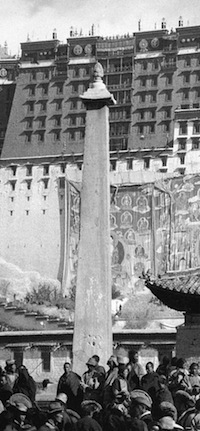
Shol Doring
This treaty pillar is sometimes mistaken for the more eye-catching Shol doring before the Potala Palace, on which is inscribed the record of another great Tibetan victory, the capture of the Tang Imperial capital of Changan in 763 AD.
As an independent nation, Tibet entered into treaties with neighboring states: Bushair 1681, Ladakh 1683 and 1842, Nepal 1856 and so on.
Tibet signed a number of treaties and conventions with Britain culminating in the Simla Treaty of 1914 by which British India and Tibet reached an agreement on their common frontier. [50] India’s present-day claims to the demarcation of its northern border (the McMahon Line) is based on this treaty which was signed by independent Tibet – not China.
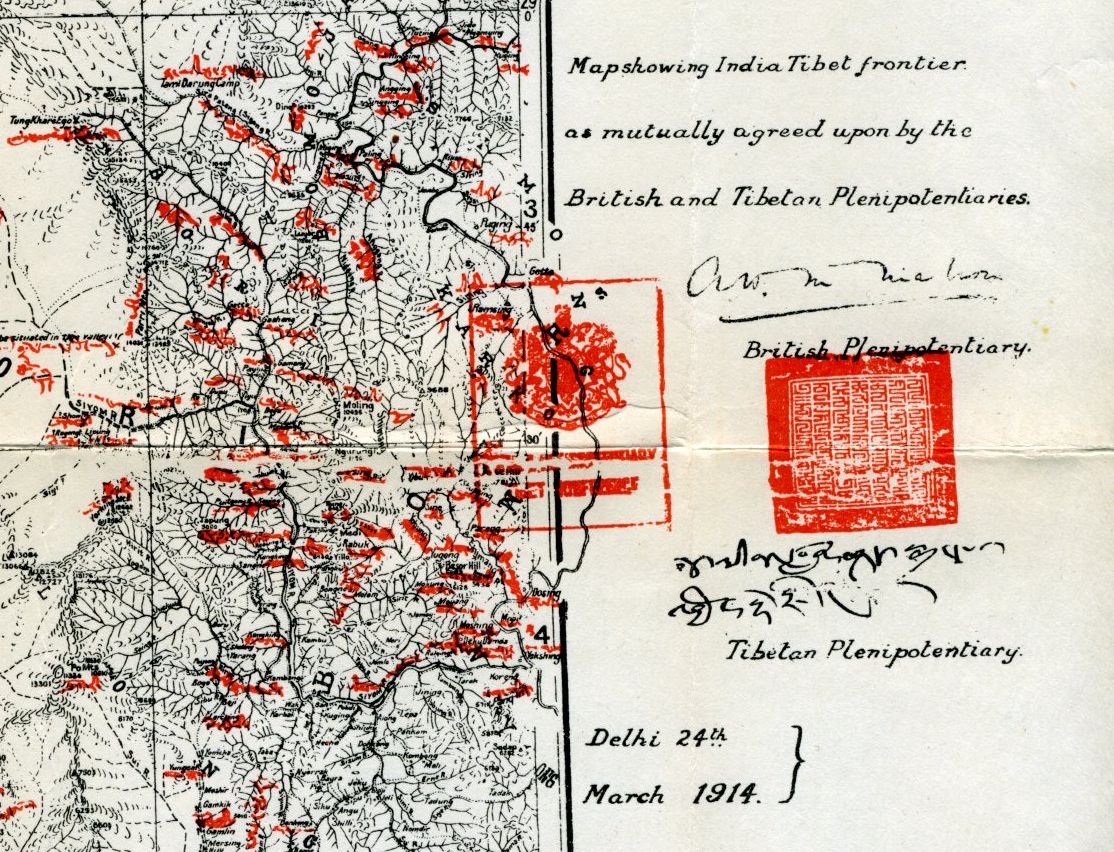
In January 1913, Tibet and Mongolia signed a treaty in Urga, the preamble of which reads: “Whereas Mongolia and Tibet having freed themselves from the Manchu dynasty and separated themselves from China, have become independent states, and whereas the two States have always professed one and the same religion, and to the end that their ancient mutual friendships may be strengthened…” [51] Declarations of friendship, mutual aid, Buddhist fraternity, and mutual trade etc., follow in the various articles. The Tibetan word “rangzen” is used throughout to mean “independence”.
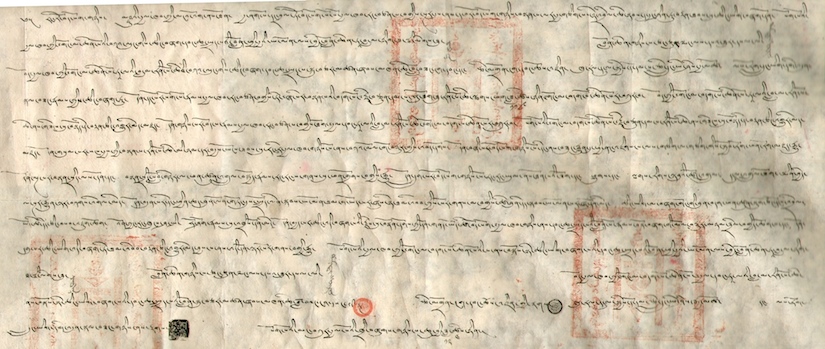
Mongolian Tibet Treaty of 1913
* * *
FOREIGN RELATIONS
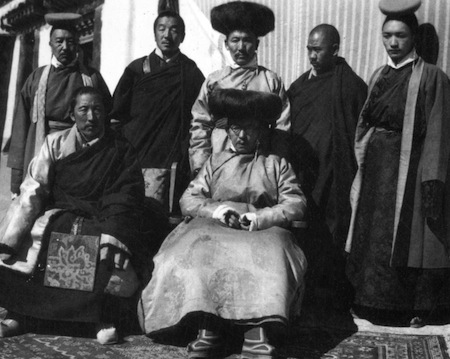
Foreign Bureau personnel
A Bureau of Foreign Affairs was established in 1909 [52] after the 13th Dalai Lama returned to Lhasa from Peking, and the Tibetan people, in symbolic rejection of Manchu rule, presented him with a new national seal. [53] The Foreign Bureau appears to have been reconstituted in 1941. [54] It conducted diplomatic relations with Britain, USA, Nepal, independent India and China. Nepal set up its legation in Lhasa in 1856, China in 1934 and Britain in 1936. Foreign ministry officials represented Tibet as an independent nation in the Inter-Asian Relations Conference convened in India March 23, 1947 to assess the status of Asia in the period following WWII. Tibet was also represented at the Afro-Asian Conference in 1948. Many participating nations were yet to be decolonized making Tibet one of the few established independent nations in that early pan-Asian gathering. [55]
A letter from the Foreign Bureau dated 2nd Nov 1949, to “Mr. Mautsetung”, describes Tibet as a religious nation, independent from “earliest times”, and requests the Communist leader to “issue strict orders” to his officers not to cross into Tibetan territory. Regarding Tibetan territory earlier annexed by China the letter states that “…the Tibetan government would like to open negotiations after the settlement of the Chinese Civil War.” [56]
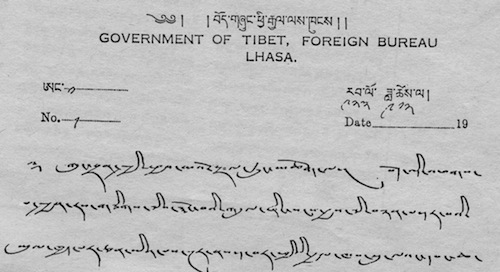
Foreign Bureau letter to Mao Tsetung
* * *
NEUTRALITY IN WORLD WAR II
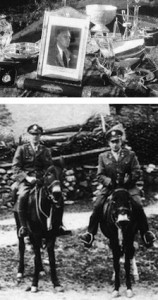 Tibet was a declared neutral country (bharnas gyalkhap) during WWII. The Tibetan government successfully resisted pressure from Britain, a threat of invasion from China, and even the personal request of President Roosevelt [57] to allow construction of a military road through Tibetan territory, or allow the passage of military supplies. In a humanitarian gesture, passage of non-military goods was later permitted. Tibet granted political asylum to two Austrian climbers [58] who escaped from a British POW camp in India. It also provided hospitality and transport to American flyers whose plane crashed in Tibet in 1944. [59]
Tibet was a declared neutral country (bharnas gyalkhap) during WWII. The Tibetan government successfully resisted pressure from Britain, a threat of invasion from China, and even the personal request of President Roosevelt [57] to allow construction of a military road through Tibetan territory, or allow the passage of military supplies. In a humanitarian gesture, passage of non-military goods was later permitted. Tibet granted political asylum to two Austrian climbers [58] who escaped from a British POW camp in India. It also provided hospitality and transport to American flyers whose plane crashed in Tibet in 1944. [59]
* * *
POST & TELEGRAPH SYSTEM
The modern Tibetan postal service was built on courier systems used during the early Tibetan Empire and later Mongol Imperial rule. A “pony express” (atrung) service was used for official missives, while general mail was carried by a system of postal-runners (bhangchen or dakpa). A Central Post and Telegraph Office (dak-tar laykhung) was created in 1920 in Lhasa [60] which took over the old postal stations (tasam) throughout Tibet. Postage stamps of various denominations were indigenously designed and hand-printed, and are now collector’s items. Though not a signatory to the International Postal Treaty, a system was created so that letters from Tibet could be delivered to foreign addresses, [61] and letters from abroad be delivered inside Tibet.
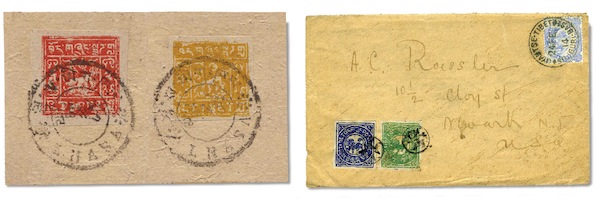
Tibetan postage stamps and envelope with New Jersey address
Spencer Chapman, visiting Lhasa in 1936, declared that, “the postal and telegraph system is most efficient.” [62] The same system continued for some years after 1950. The Czech filmmaker Vladimir Cis (working for the Chinese Communist government) had a letter from his family in Prague delivered to him in the wilderness of Tibet by a postal-runner in 1954. [63]
A telegraph line from India to Lhasa was completed in 1923, along with a basic telephone service. Both were open for public use. The event was commemorated in a publication of the Royal Geographical Society, London. [64]
The Tibetan capital was electrified in 1927. The work of installing both the hydroelectric plant and the distribution system was undertaken near “single-handedly” [65] by a young Tibetan engineer, Ringang. All these projects were initiated and paid for by the Tibetan government.
Radio Lhasa was launched in 1948 and broadcasted news in Tibetan, English and Chinese. [66]
* * *
WITNESSES TO INDEPENDENT TIBET
The fact that Tibet was a peaceful, independent country is attested to by the writings of many impartial western observers who not only visited pre-invasion Tibet, but even lived there for considerable periods of time – as the titles of some of their memoirs seem to proudly proclaim: Twenty Years in Tibet by David McDonald [67], Seven Years in Tibet by Heinrich Harrer [68], and even Eight Years in Tibet, the biography of Peter Aufschnieter. [69]
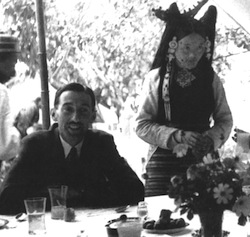
Richardson at a Lhasa garden party
The premier scholar on Tibet, Hugh Richardson, lived for nine years in Tibet, and his many writings [70] reveal a country that was functioning, orderly, peaceful and with a long history of political independence and cultural achievement. He later wrote, “The British government, the only government among Western countries to have had treaty relations with Tibet, sold the Tibetans down the river…” Richardson also acknowledged that he was “profoundly ashamed” [71] at the British government’s refusal to recognize Tibet’s historically independent status.”

Sir Charles Bell
Another great scholar and diplomat, Charles Bell, regarded as the “architect of Britain’s Tibet policy,” was convinced that Britain and America’s refusal to recognize Tibetan independence (but which they sometimes tacitly acknowledged when it was to their advantage) was largely dictated by their desire “to increase their commercial profits in China.” [72]
It is almost certain that none of the official propagandists who demonize Tibet in Chinese publications had witnessed life in old Tibet. In fact, none of Beijing’s Tibet propagandists in the West (Michael Parenti, Tom Grunfeld, Barry Sautman, Melvin Goldstein et al) [73] had visited Tibet before 1980. The first two misrepresent old Tibet by selectively quoting English journalists and officials (L. A. Waddell, Percival Landon, Edmund Candler, Captain W.F.T. O’Connor) who accompanied the British invasion force of 1904, and who sought to justify that violent imperialist venture into Tibet by demonizing Tibetan society and government.
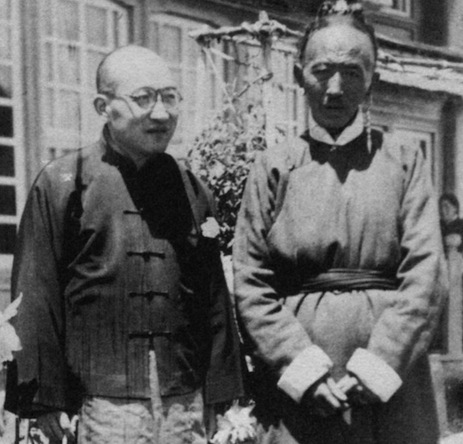 The only high-ranking Chinese official with scholarly credentials who spent any length of time in old Tibet was Dr. Shen Tsung-lien, representative of the Republic of China in Lhasa (1944-1949). In his book Tibet and the Tibetans, Dr. Shen writes of a nation clearly distinct from China, and one that “…had enjoyed full independence since 1911.” He writes truthfully of a hierarchical, conservative society “fossilized many centuries back” but whose people were orderly, peaceable and hospitable – but also “notorious litigants,” adding that “few peoples in the world are such eloquent pleaders.” Shen also mentions “Appeals may be addressed to any office to which the disputants belong, or even to the Dalai Lama or his regent.” [74]
The only high-ranking Chinese official with scholarly credentials who spent any length of time in old Tibet was Dr. Shen Tsung-lien, representative of the Republic of China in Lhasa (1944-1949). In his book Tibet and the Tibetans, Dr. Shen writes of a nation clearly distinct from China, and one that “…had enjoyed full independence since 1911.” He writes truthfully of a hierarchical, conservative society “fossilized many centuries back” but whose people were orderly, peaceable and hospitable – but also “notorious litigants,” adding that “few peoples in the world are such eloquent pleaders.” Shen also mentions “Appeals may be addressed to any office to which the disputants belong, or even to the Dalai Lama or his regent.” [74]
* * *
REFERENCE NOTES:
1. In 1642, the Fifth Dalai Lama issued the Rilung Tsatsik (ri klung rtsa tshig) generally translated as the Mountain Valley Edict. Another source describes it as a Decree for the Protection of Animals and the Environment. Since then, this edict was re-issued annually till 1958. Following the New Year Festivities, copies of the edict were distributed nationwide, and were displayed and read out to the assembled public by district officials. In order that its message suitably awe and instruct the document itself was physically impressive: about 3 feet wide and 6 or 7 feet in length, richly decorated with auspicious symbols and artwork around the border, and with the seal of the Dalai Lama at the bottom. French, Rebecca Redwood. The Golden Yoke, p 208, 209 & 213.
2. According to the scholar, Tashi Tsering (director of the Amnye Machen Institute) there are references to “Mountain Valley” edicts being issued during the Rimpung dynasty and the Tsangpa kings.
3. Bell, Charles. Tibet Past and Present. London: Oxford University Press, 1924. See index: “Capital punishment abolished in Tibet, 142, 143, 236.”
Byron, Robert. First Russia then Tibet. London: Macmillan & Co., 1933. pg 204: “Capital punishment was now abolished.”
McGovern, William. To Lhasa in Disguise. New York: Century Co., 1924. pg 388-389.
Kingdon-Ward, Frank. In the Land of The Blue Poppies. New York: Modern Library, 2003. pg 22.
Winnington, Alan. Tibet: The Record of a Journey. London: Lawrence & Wishart Ltd., 1957. pg 99.
Brauen, Martin. Peter Aufschnaiter’s Eight Years in Tibet. Bangkok: Orchid Press, 2002. Pg 77: “There was no death penalty…”
4. The few books available on Muslims in Tibet clearly reveal the tolerance of Tibetan government, church and society for this minority group:
Henry, Gray. Islam in Tibet. Louisville, Kentucky: Fons Vitae, 1997.
Nadwi, Dr. Abu Bakr Amir-uddin. Tibet and Tibetan Muslims, Dharamsala: Library of Tibetan Works & Archives, 2004.
5. The plant hunter Kingdon-Ward writing of Khampas mentions that “the men are great travellers and leave their wives behind for months at a time, and these good folk solace themselves as best they can with other travellers.” Kingdon Ward sees this contributing to the Tibetan custom of polyandry. He sees supporting evidence for his conjecture in the Lutzu who though in contact with Tibetans “…as far as I am aware, are monogamous, which adds weight of negative evidence in favour of the above theory, since the tribes are notorious stay-at-homes.”
Kingdon-Ward, Frank. (ed. Tom Christopher) In the Land of The Blue Poppies. New York: Modern Library, 2003. P175
6. Goldstein, Melvyn. A Tibetan Revolutionary: The Political Life and Times of Bapa Phuntso Wangye. University of California Press, 2004, pg 137.
7. Chang, Jung & Jon Halliday. Mao: The Unknown Story. London: Jonathan Cape, 2005.
8. Ford, Robert. Captured in Tibet. London: George G. Harrap & Co., Ltd, 1957. pg 158.
9. Bull, Geoffrey T. When Iron Gates Yield. London: Hodder & Stoughton, 1955. pg 130.
10. Goldstein, Melvyn. A Tibetan Revolutionary: The Political Life and Times of Bapa Phuntso Wangye. University of California Press, 2004, pg 139.
11. O’Ballance, Edgar. The Red Army Of China. London: Faber & Faber, 1962. pg 189-190.
12. Kong Fei-tsi (?), tse srog gi bhul skyes (Gift of Life) translated by Wanglag, Tibetan Peoples Publishing House, Lhasa, 2001.
13. Norbu, Jamyang. “The Forgotten Anniversary – Remembering the Great Khampa Uprising of1956″. Thursday, December 07, 2006, Phayul.com.
14. Tsarong, Dundul Namgyal. In the Service of His Country: The Biography of Dasang Damdul Tsarong Commander General of Tibet. Ithaca: Snow Lion Publications, 2000. pg 51.
15. Grosvenor, Gilbert and William J. Showalter, “Flags of the World”. The National Geographic Magazine: September, 1934 – Vol. LXVI – No. 3. Washington, D.C.” National Geographic Society, 1934.
16. Tibet Nationalflagge, Bulgaria Zigarettenfabrik, Dresden,1933. (From a series non-European countries, pictures 201-400) From the collection of Prof. Dr. Jan Andersson of Germany, and reproduced with his kind permission.
17. Grosvenor, Gilbert H. “The Heroic Flags of the Middle Ages.” The National Geographic Magazine: October, 1917 – Vol. Xxxii – No. 4. Washington, D.C.: National Geographic Society, 1917.
18. Lux-Wurm, Pierre C. “The Story of the Flag of Tibet.” Flag Bulletin: Vol. XII – No. 1. Spring 1973.
19. On 23 March 1947 the Inter-Asian Relations Conference was convened in India to assess the status of Asia in the period following WWII. At this gathering, Tibet was represented as an independent nation, as evidenced by the country’s delineation on a conference map and the first appearance of the Tibetans’ national flag. The Chinese (Guomindang) were furious and protested formally to the organizers of the conference. The Tibetan flag was hoisted and also a flag emblem was displayed before the delegates on the dias. Mahatma Gandhi addressed this conference. The representatives of the Tibetan foreign bureau, Theiji Sampo Tenzin Thondup, Khenchung Lobsang Wangyal and Kyibug Wangdue Norbu (translator) also took part in the Afro-Asian Conference held in Delhi in 1948. Interestingly many of the participating states were yet to be decolonized making Tibet one of the few established independent nations at this pan-Asian gathering.
(Photograph of conference)
20. OLD TIBETAN NATIONAL HYMN
Ghang ri rawe kor we shingkham di
Phen thang dewa ma loe jungwae ne
Chenrezig wa Kalsang Gyatso yin
Shelpal se thae bhardu
Ten gyur chik
Circled by ramparts of snow-mountains – this sacred realm,
This wellspring of all benefits and happiness.
Kalsang Gyatso, bodhisattva of compassion
May he reign till the end of all existence
(translated by Jamyang Norbu)
21. The eminent Tibetan scholar, Tashi Tsering citing the historical work Bka’ blon rtogs brjod, says that this verse was composed by the Tibetan ruler, Phola lha nas, (in 1745/46) in praise of the 7th Dalai Lama. “Reflections on Thang stong rgyal po as the founder of the a lce lha mo tradition of Tibetan performing arts,” The Singing Mask: Echoes of Tibetan Opera, Lungta, Winter 2001 No 15, eds. Isabelle Henrion-Dourcy and Tashi Tsering)
Woodblock reproduction of Pholanas courtesy of Tashi Tsering.
22. Audio clip of namthar (opera aria) of National Hymn sung by Techung accompanied by Nima Gyalpo, courtesy of Chaksampa Opera Company, San Francisco.
23. Lyrics composed in 1959 by Kyapje Trichang Rinpoche, tutor of His Holiness the Dalai Lama at Mussoorie, U.P.
The Collected Works of the Glorious Master of the Dharma, Yongzin Trichang Vajradhara (yongjog tempae ngadak kyapche yongzin trichang dorjee chang chempoe sungbum), published by Mongolian Lama Guru Deva, New Delhi, Vol Gha, pg 299.
24. (Image) A map of Asia drawn by the Dutch cartographer, Pietar van der Aa around 1680 shows Tibet in two parts but distinct from China.
25. (Image) A map of Asia drawn by the French cartographer, Guillaume de L’isle, around 1700, where Tibet is referred to as the “Kingdom of Grand Tibet.”
26. (Image) “Map of Hindoostan, Farther India, China and Tibet”. Constructed & engraved by W.Williams, Phila. Entered according to Act of Congress in the year 1877 by S Augustus Mitchell in the Office of the Librarian of Congress at Washington.
27. (Image) An 1827 map of Asia drawn by Anthony Finley of Philadelphia, clearly showing “Great Tibet” as distinct from the Chinese Empire.
28. Ravenstein, Ernest George. (1834-1913) Martin Behaim: His Life and his Globe, (With a facsimile of the globe printed in colours, eleven maps and seventeen illustrations), G. Philip & Son, Ltd., London. 1908.
This globe was kindly brought to the compiler’s attention by Robert Palais of San Francisco, who provided in (JN’s blog) various sources where information on the Behaim globe could be obtained:
University of Utah
Wikipedia
Henry Davis Consulting (image)
Henry Davis Consulting (description)
29. The Mapparium, is a thirty-foot stained-glass globe room in the lobby of the Christian Science Publishing Society in Boston, which gives one a unique “inside view” of the world. The political boundries are frozen circa 1935. It was based on Rand McNally’s 1934 map of the world. At this size, the scale amounts to approximately 22 miles to the inch. In the photograph Tibet (pink) can be seen directly at the back above British India (red) and to the side of China (yellow). Check these websites for history and directions.
roadsideamerica.com
designorati.com
30. Norbu, Dawa. China’s Tibet Policy. Richmond Curzon, 2001
Information Office. Mongols and Tibet. (Image)
31. According to the Tibetan researcher Lugar Jam (conversation on July 2009) the names of the two Mongol monks sent by Jesuit cartographers to Tibet were Tsultrim Sangpo (churbizanbo) and Lhamo Tempa (lanbenzhanba).
32. Hostetler, Laura. Qing Colonial Enterprise: Ethnography and Cartography in Early Modern China. Chicago: University of Chicago Press, 2001.
33. For instance we have, from the biography of Milarepa, the story of Milarepa’s mother sewing seven pieces of gold in a traveller’s cloak, to secretly send to her son.
34. Bertsch, Wolfgang. The Currency of Tibet. Dharamsala: Library of Tibetan Works & Archives, 2002.
35. Bertsch, Wolfgang. A Study of Tibetan Paper Money: With a Critical Bibliography, Dharamsala: Library of Tibetan Works & Archives, 1997.
36. Rhodes, N.G. “The First Coins Struck in Tibet”. Tibet Journal. Winter 1990: (LTWA), Dharamsala.
37. Richardson, Hugh. “Reflections on a Tibetan Passport”. High Peaks Pure Earth: Collected Writings on Tibetan History & Culture. London: Serindia Publications, 1998. pg 482.
38. Das, Sarat Chandra, An Introduction the the Grammer of the Tibetan Language, Motilala Banarasidas, Delhi 1972. Appendix 1, pg 4-5. (Reproduction of the Lhasa and Shigatse passports issued to Purangir Gossain.)
39. Bell, Charles. Portrait of a Dalai Lama: The Life and Times of the Great Thirteenth. Boston: Wisdom Publications, 1987. pg 278.
(Facsimile of 1st Everest passport; courtesy of Rinchen Dorjay who photographed it at the museum of the Himalayan Mountaineering Institute, Darjeeling.)
40. Gould, B.J. The Jewel in the Lotus: Recollections of an Indian Political. London: Chatto & Windus, 1957. pg 210-211.
(Facsimile of Passport. Photograph of Rai Bahadur Norbu Thondup holding the passport.)
41. Englehardt, Isrun. Tibet in 1938-39: Photographs from the Ernst Schafer Expedition to Tibet. Chicago: Serindia, 2007. pg 121. (Facsimile of Passport.)
42. Tucci, Guiseppe. To Lhasa and Beyond. New Delhi: Oxford and IBH, 1983. pg 14-15. (Facsimile of passport.)
43. Cox, Kennith. Frank Kingdon Ward’s, Riddle of the Tsangpo Gorges. United Kingdom: Antique Collector’s Club, 2001. pg 75.
44. Tolstoy, Lt.Col. Ilia. “Across Tibet From India To China”. The National Geographic Magazine. Washington, D.C.: National Geographic Society, August 1946. “This letter was a piece of red cotton cloth about 16 inches wide and two feet long, to be carried in the bosom or on a staff by an outrider who would precede the party by one or two days. It stated that two American officers were en route to visit the Dalai Lama…”
45. Thomas, Lowell Jr. Out of This World: Across the Himalayas to Forbidden Tibet. New York: The Greystone Press, 1950. pg 79-80. (Facsimile of passport and photograph of Lowell Thomas receiving his passport at Yatung.)
46. Bell, Charles. Portrait of a Dalai Lama: The Life and Times of the Great Thirteenth. Boston: Wisdom Publications, 1987. p 420. (Bell mentions that a passport was issued to Diwan Bahadur Phala who visited England in 1925.)
47. Facsimile of Shakabpa passport, courtesy of Friends of Tibet, India.
48. Richardson, Hugh. High Peaks Pure Earth: Collected Writings on Tibetan History & Culture. London: Serindia Publications, 1998. Plate 10. (Photograph of Treaty Pillar of AD 821-822 within protective enclosure.)
49. Richardson, H.E. Tibet and Its History. London: Oxford University Press, 1962. 244-245
50. The Sino-Indian Boundary Question (Enlarged Edition). Peking: Foreign Language Press,1962. Photostat of eastern sector of original map of the McMahon line with signatures and seals of Tibetan and British plenipotentiaries, Delhi 24 March 1914. Original scale 1:5000,000.
51. Facsimile of the Tibet-Mongolia Treaty of 1913. Translation in
Richardson, H.E. Tibet and Its History. London: Oxford University Press, 1962. 265-267.
52. Shakabpa, Tsepon W.D. Tibet:A Political History. Yale University Press, 1967. 227.
53. Shakabpa, Tsepon W.D. Tibet:A Political History. Yale University Press, 1967. Frontispiece.
54. Neushar, Thupten Tharpa. bhod shung tse yiktsang dang chegyal las khung. (The “Peak” Secretariate and the Foreign Bureau of the Tibetan Government). Oral History Series No: 5, Library of Tibetan Works & Archives, Dharamshala, 1998. Neushar states that the Foreign Bureau was set up during the Taktra Regency in the iron serpent year (1941). The office was located south-west of the Tsuglagkhang, and headed by Dsazak Surkhang (zurpa) Wangchen Tseten, and Ta Lama Kunchok Jungnas. Shakabpa in his History claims that the Foreign Bureau was created around 1913.
55. On 23 March 1947 the Inter-Asian Relations Conference was convened in India to assess the status of Asia in the period following WWII. At this gathering, Tibet was represented as an independent nation, as evidenced by the country’s delineation on a conference map and the first appearance of the Tibetans’ national flag. The Chinese (Guomindang) were furious and protested formally to the organizers of the conference. The Tibetan flag was hoisted and also a flag emblem displayed before the delegates on the dias. Mahatma Gandhi addressed this conference. The representatives of the Tibetan foreign bureau, Theiji Sampo Tenzin Thondup, Khenchung Lobsang Wangyal and Kyibug Wangdue Norbu (translator) also took part in the Afro-Asian Conference held in Delhi in 1948. Interestingly, many of the participants were yet to be decolonized making Tibet one of the few established independent nations at this early pan-Asian gathering.
(Photograph of conference)
56. Facsimile. Letter courtesy of the Amnye Machen Institute, Dharamshala.
57. Tolstoy, Lt.Col. Ilia. “Across Tibet From India To China”. The National Geographic Magazine. Washington, D.C.: National Geographic Society, August 1946.
58. Harrer, Heinrich. Seven Years in Tibet. London: Rupert Hart Davis,1953.
Brauen, Martin. Peter Aufschnaiter’s Eight Years in Tibet. Bangkok: Orchid Press, 2002.
59. Starks, Richard & Murcutt, Miriam. Lost in Tibet: The Untold Story of Give American Airmen, a Doomed Plane and the Will to Survive. The L:yons Press, Connecticut, 2004.
60. Waterfall, Arnold C. The Postal History of Tibet. London: Robson Lowe Ltd., 1965.
61. Photographs of letter to Mr.A.C.Rosslier of Newark, NJ, and various Tibetan stamps.
62. Chapman, F. Spencer. Lhasa the Holy City. London: Chatto and Windus, 1940. pg 87.
63. Cis, Peter. Tibet, Through the Red Box. New York: Francis Foster Books, 1998.
64. King, W.H. “The Telegraph to Lhasa”, The Geographical Journal, Vol. 63 (Jun., 1924). Pp 527-531. Published by: Blackwell Publishing on behalf of the Royal Geographical Society (with the Institute of British Geographers).
Group photograph of officials, engineers, crew and local laborers involved with the telegraph line. Sitting from left to right: Mr. Sonam Tsering of Kalimpong (sent on deputation by Indian Postal Dept.), first telegraph master of Lhasa. Mr. Ringang, Mr. W.H. King (chief engineer), Mr.W.P.Rosemeyer (assistant engineer), and Mr Kyibuk, official interpreter. The officials Kesura and Jorgay were also employed as supervisors, but are not in the photograph.
65. Tsarong, Dundul Namgyal. In the Service of His Country: The Biography of Dasang Damdul Tsarong Commander General of Tibet. Ithaca: Snow Lion Publications, 2000. pg 62.
66. In 1948, Radio Lhasa started the first of its daily broadcasts to the outside world. At five p.m., the station would go on air. The news was read in Tibetan, and then in English by Reginald Fox or by Kyibuk, one of the surviving Rugby students and an official at the Tibetan Foreign Bureau. Finally, the news was read in Chinese by Phuntsok Tashi Takla, the Dalai Lama’s brother-in-law. Official announcements were also read over the radio, as this one prepared by Aufschnaiter: “We have the honour to announce that Radio Lhasa will broadcast an announcement of the enthronement of His Holiness the Dalai Lama, the ruler of Tibet, together with a proclamation of the Tibetan government to the Tibetan people and the world, on Friday 17 November 1950, at 5.45 p.m. Indian Standard Time.” (Brauen, Martin. Peter Aufschnaiter’s Eight Years in Tibet. Bangkok: Orchid Press, 2002.)
67. David, MacDonald. Twenty Years in Tibet. New Delhi: Vintage Books, 1991. (first published1932).
68. Harrer, Heinrich. Seven Years in Tibet. London: Rupert Hart Davis, 1953.
69. Brauen, Martin. Peter Aufschnaiter’s Eight Years in Tibet. Bangkok: Orchid Press, 2002.
70. Richardson, H.E. Tibet and Its History. London: Oxford University Press, 1962.
Richardson, H.E. and David Snellgrove. A Cultural History of Tibet. London: George Wiedenfeld & Nicholson,1968.
Richardson, H.E. High Peaks Pure Earth: Collected Writings on Tibetan History & Culture. London: Serindia Publications, 1998.
71. Wikipedia
72. Bell, Charles. Portrait of a Dalai Lama: The Life and Times of the Great Thirteenth. Boston: Wisdom Publications, 1987. 396.
73. Norbu, Jamyang. “Running-Dog Propagandists” Phayul.com, [Monday, July 14, 2008 09:37]
74. Shen, Tsung-lien and Shen-chi Liu. Tibet and the Tibetans. California: Stanford University Press, 1953.112.



Thanks again for this useful Rangzen handbook which provides documentation of Tibet’s sovreignity and just claim to independence
FREE TIBET NOW!
Dear Jamyang,
as always a very precise and useful article. I hope that will help Tibetans and non Tibetans to understand the real situation of Tibet before Chinese invasion of 1950.
And I hope too, that will help all of us to understand that it is essential do not give up the struggle for the complete independence of Tibet.
Pö Rangzen!
You are right, it is much better and has a lot more information. Thank you very much. Rangzen.
Votre article donne clairement des faits et des preuves matérielles en faveur d’une juste revendication d’indépendance du Tibet.
Merci pour ce travail.
You said “The Jesuits could not personally survey Tibet (as they had surveyed China and Manchuria), since Tibet was not part of the Chinese Empire. So they trained two Mongol monks [32] in Beijing and sent them to make a secret survey of Tibet”
I have two points to make. (1) none of these maps included Tibet was parts of China and political boundaries were not clearly drawn. For example, Korea was included as a part of China. In later visions, a Tibet map was included ,but not as part of China.
(2) there are no evidences to suggest that these monks were Mongolians and I think they were Tibetans. Until late 19th century, none of Chinese maps included Tibet was the part of China.
You write: “The oldest existing globe in the world, and possibly the first terrestrial globe ever made, was constructed by Martin Behaim (geographer to the king of Portugal) in 1492. It depicts the world before the discovery of the Americas. Tibet is clearly identified in German as “Thebet ein konigreich”, or “Tibet, a kingdom”. [29]”
In history we recite a song,”In 1492, Columbus sailed the ocean blue” Were there actual globes manufactured in 1492 while the consensus was that the earth was flat?
Amdowa,
I you had read this section carefully you will have noted that I wrote that following the publication of the Kangxi atlas “some Chinese and European maps begin to depict Tibet as a colony or protectorate of China.” I did not make any statement as to how the actual Kangxi maps demarcated Tibet. There are three versions of the Kangxi Jesuit maps now housed in the British Library conveying different nuanced understanding of what constituted China, on one hand, and the Qing empire on the other. But nonetheless, Paul Pelliot noted that “the Kangxi atlas and its European edition had a very powerful impact on Western perception of China’s boundaries”.
That the two monks were Mongols appear in nearly all accounts of their training in Peking by Jean-Baptiste Régis, the Jesuit cartographer. The Tibetan research scholar, Lugar Jam (in a conversation with me on July 2009)concurred. He also told me that their names were Tsultrim Sangpo and Lhamo Tempa – churbizanbo and lanbenzhanba, in pinyin.
I would be grateful if you would let me know what evidence you might have on the monks being Tibetan. It would also be useful if you could cite the exact maps that you broadly mention in the beginning of your comment.
Pema,
Yes ordinary people at the time believed the world was flat (some still do in our own society). But enlightened people as far back as ancient Greece had known the earth was round, and one (Eratosthenes)even measured its circumference in 240 BC. But The Portuguese, who were the greatest explorers and navigators at the time the globe was made, certainly knew the world was spherical. The story that Christopher Columbus set out to prove that the world was round is a complete myth. He and his colleagues and sponsors all knew the world was round. They just didn’t know America was in the way of their route to India.
Hi Jamyang
I’m trying to find a document to cite that defines Tibet’s motto – if it ever had one.
I want to add this to the wiki page on national mottos.
http://en.wikipedia.org/w/index.php?title=List_of_national_mottos
I added om mani padme hum, but someone deleted it because they say its not a motto, and in all fairness I had nothing to cite.
Thanks
PS I don’t speak Tibetan.
PSS I couldn’t find your contact email, so I just added this comment.
Dear J. Norbu,
It is immensely encouraging to go through your writings and especially this one I think weigh so much. No matter what we are fighting for, truth should always be told, exposed and denuded from the attempts of colouring the facts, doing injustice to History. I will make as many people as possible to read this, Coz emotional outbursts of nationalism is not the way, it would only rape our reason and rectify nothing. We need brain, not brawn.
Thanks
just fyi,
rinchen lhamo–the author of “we tibetans” from dhartsedo, kham immigrated to england –through marriage with an english officer– in the 20’s.. long before the chinese invasion 49/50. got your point though.
the book paints a portrait of Tibet in the early 1900’s, pre-Chinese invasion. a must read.
Hi Jamyang N la
thanks for your enriched source proved once again Tibet was an independent nation.
We all know that Millions of poeple and leaderships of many of nations already knew Tibet once was free country.
The real question is here. How we can push china’ leadership to change their minds and open to us to talk about tibet’s rights freely and seriously?
for the past 9 around of talks there is no seriousness from China side. but they still wants world to see
China is dialoge with Exile government. They attetion is not to solve the problem rather show th world China is willingly to talk but they still want HH and tibet government give up everything.
Everytime envoys of HH returned from China. They openly critizie HH and Tibet government. make things worse…
I mean what we can do to make China understand what HH’s middle way approuch.
Are you going to stay like this for ever? or We still need to change some thing to make thing happen?
Great Tibet resources…I have just returned from volunteer teaching conversational English in McleodGanj with the Tibetan exile community and am planning to return btwn Aug-Oct 2010.
Looking forward to reading more of your blog.
Keep up the great work.
Pema Kadag wrote:
“Were there actual globes manufactured in 1492 while the consensus was that the earth was flat?”
There was no such consensus. Since the ancient Greeks, educated Westerners have believed that the earth is a globe (and we don’t really know what the masses believed).
The idea that everyone believed the earth was flat before Columbus disproved it is a myth peddled by an American popular historian whose name I can’t currently recall (was it George Washington Grover?) He thought the truth – that Columbus was mainly interested in developing new trade routes – wasn’t sufficently grand a purpose for the voyage that “discovered” America. It’s not quite in the same league as China’s version of Tibetan history – that Tibet was a health on earth ’til the PLA liberated it – but it is still poor history and needs correcting.
I think very little is known about the background of these two geographer lamas namely Culcim and Dsangbu Ramjamba. There were definitely two monks accompanying the Mongolian superintendency Senju in 1717 but is debated whether Culcim and Dsangbu are the names of the two monks. One source say that the name of the other monk is not known. That Culcim and Dsanbu are in fact one name. Culcim is the Tibetan name Tsultrim and the other had a monastic degree Ramjamba.
This is a good improvement on an excellent resource, but when I go to rangzen.net for a printable version as suggested in the intro paragraph, I am only finding the older version. Am I doing something wrong, or is this new version not there yet? Thanks.
Prof. Jamyang Norbu la, thang you so much for your independent imformation. and also Gyeduen Rabsel which is your article translate in to Tibetan scrip its very importand for like me. which is not very clear undrestant in english. please i more requesting to you both, jamyang la whatever your article are please try to translate in to tibetan scrip. thank you again. from sonam
Jamyang la,
Thank you again for this wonderful researched paper. You are undoubtedly THE MAN who is doing great service to the country and its inhabitants, both living and dead.
My maternal gradparents and their relatives told me many great heroic stories about their resistance against the invading chinese forces. Yet i don’t see any reference in the literature. All the resistance fighters were Khampas and Amdos and not u-tsang or for that matter NGari.
Besides Gertse, Gerge, nearby nomadic community fought relentlessly against the chinese. Many of my ancestor’s relatives (elders) were killed. Many others were imprisoned and later killed because of their efforts to regroup the fleeing people to fight the chinese.
Thanks again for the research and this present. YOu have done great justice to those who passed away fighting for our greater goal.
KP
Billk,
The name of the writer was Washington Irving. He published a lengthy biography of Columbus in 1828. In it was the first time the idea appeared that humanity thought the earth was flat. Informed persons as well as sailors have always known the earth was a sphere. In Western civilization, the first antecedents who knew the earth was a sphere were the Phoenicians, who predate the Greeks.
There are many myths regarding Columbus that are considered historical facts by many people. The other main one being that he died without ever knowing he had found a previously unknown (to most Europeans) continent. He left diary entries which show that he figured this out almost immediately. (He also left entries about what he thought should be done about the native populations…which sadly were carried out almost to the letter).
Billk,
The name of the writer was Washington Irving. He published a lengthy biography of Columbus in 1828. In it was the first time the idea appeared that humanity thought the earth was flat. Informed persons as well as sailors have always known the earth was a sphere. In Western civilization, the first antecedents who knew the earth was a sphere were the Phoenicians, who predate the Greeks.
There are many myths regarding Columbus that are considered historical facts by many people. The other main one being that he died without ever knowing he had found a previously unknown (to most Europeans) continent. He left diary entries which show that he figured this out almost immediately. (He also left entries about what he thought should be done about the native populations…which sadly were carried out almost to the letter).
kp,
lithang adha said in a video that there were 30 divisions(1000 fighters per division) in chushigangdruk, each named after a tibetan letter. he said only one division belonged to amdos. and no utsangs. yes, 29 divisions were khampas. so he said.
when asked why he did not fight the chinese in his “toe” village my dad said “we had no weapons nor instruction nor organisation. chinese were seldom seen in my village. it’s not that we were incapable of fighting”.
then after a long thought, he said it was sad he was forced(by their conduct) to kill 4 tibetans in different situations and cut off the left hand of four others and beat up 8 others. their crime against father’s family and relatives was banditry, rape and murder including the murder of an infant-his uncle’s son.
“fkd up indeed” said i.
Gautam and Dave,
New PDF versions of “Independent Tibet: The Facts” will be available soon on rangzen.net, in English, Tibetan and Chinese. An announcement will be made as soon as the material is uploaded.
Golok Ambum
Webmaster
Tseringpo lak,
According to a relative of Chushi Gangtruk veteran, there were a handful of U-Tsang fighters when Chushi Gangtruk was formally established in Lhoka region of Tibet. At that time, probably due to small number, they did not form a separate division for themselve. They just included themselves either in Amdowa or Khampas as they like.
I think it was not due to lack of courage or nationalism from U-Tsang people, but due to lack of information and recruiting problems.
why do I get strange feeling that only most foregners are appreciative of this blog that is proving Tibetan rangzen. Tibetans like Amdowa, Pema Kadak, Tseringpo do not seem to like this blog and trying to put it down with stupid comments, although they are not succeeding. If Middle Path people want to be part of China then go to China, now. Nobody is stopping you.
T.D‘s comment on Chushi gangdruk is correct regarding utsang participation in fighting the Chinese under the Chushi gangdruk flag. I joined the organization in 1973 for a brief time before it fell apart. During my brief stint I met several people from Utsang and because we did not have a significant group we were integrated with the different Khampa squads.
Now as far as my personal take on the matter I am of an opinion that several factors may have contributed to why there were less people from Utsang joining in the resistance movement. Firstly, Utsang folk did not have easy access to weapons like our brothers from Kham and had no experience using firearms. Secondly, Utsang folks being organized under a landlord tenant system and could not freely leave the family and responsibilities to the land and join up. Thirdly, Utsang people are mild mannered and simple folk who regarded fighting to be the responsibility of the army. Yet, in spite of all these drawbacks Utsang folk have fought the Chinese in their own way individually or in groups though they did not belong to the Chushi gangdruk.
And lastly as for fighting the Chinese goes, folks must remember that the bulk of the Tibetan army who fought almost to the last man in Lhasa was from Utsang. Therefore, the question of Utsang participation in Chushi gangdruk is an irrelevant point for the bulk of the fighting done ind and around Lhasa with the Chinese were from Utsang and neighbouring nomadic people. Having said this, I have great respect for our Khampa and Amdo brothers who fought the Chinese most bravely on their own terms and continued the resistance even after we came into exile.
What’s going on? Now you started to argue who is brave and who is not?
I already said once befere, in my village even children and women assisted fighting against red army by collecting rockes and other tools for men fighters.
I have no slightest doubt to question of bravery of Tibetan men, women, even younger ones acrosss the land of snows at the time chinese slaughters put axes on our neck.
Please read as I have no slightest doubt over bravey…..
My father was a monk at the time when Chinese red army first came to our village, he told me that his monastery surrounded in the middle of night, they never saw a single Chinese army before but heard they are coming.
he said there were no organizations of Tibetan fighters, tibetans in his area fought them by in small groups at the local level, it was in early 50s.
My father eneaked away and joined a goup of 30 or 50 people mixed both laity and monks in lay clothes.
Among them Only few lay people carried fire arms, most of them were with regular tools such as wooden clubs, rocks, axes and herder’s slings.
Their fight lasted for days and in the end, many were killed and ramaining were captured.
My father told me that there were two brothers among them , they carried fire armes , they fought fiearcely and n the end they ageet to shot each other before captured by Chinese army when their arm powders remained to the last dust.
In terms of organization, skills and weapons there is no dispute that Chushi Gangdruk had all the trappings of a resistance force that the Chinese feared; and there is no dispute here that many brave men from this organization died for our country.
However, the question is not of who is brave and who is not, rather an unhealthy misunderstanding that all the fighting was done by Khampa’s and Amdos, that the people of Utsang played no part in resisting the Chinese. All Tibetans, whether from Kham, Amdo, Golok, Jangthang, Kongpo or Utsang, each in their own way resisted the Chinese occupation as much as they able to. Therefore the story of Tibetan resistance must be told in its entirety and not pit one region against another. It is a natural tendency to romanticize the Khampa effort especially in view of the CIA involvement, and the wide spread information available on the subject, yet it would be unfair to claim that people from Utsang and other regions played no part in resisting the occupation.
I totally agree.
When I read Jamyang Norbu la’s article demanding special recognition or commemoration for “kampa Resistance'”. I thought of those hundreds of unheard local resistances across the three regions and I wondered if the demand is fair.
So many local fights and wars against Chinese army were waged even in a small region where I come from, but only few of them were heard by others and almost none were recorded.
Most people in my area didn’t have the privilege to escape out at the time, so their stories were only whispered at their homes in world’s most remote countryside.
Hi,
I’m a Salar originally from Qinghai Province on the edge of Amdo, on the Huanghe/Machu. Our ancestors settled there during the Mongol Empire in the 14th Century from Central Asia. We are Muslim and Turkic-speaking and have lived among Tibetans and Han in relative peace in the past five hundred years (I use “Han” to indicate ethnicity because those of us other non-Han peoples are also “Chinese” in terms of our citizenship). The hometown of the late Panchan Lama is just one hour away from my home town. When I look at the map of your future independent Tibet (the Greater Tibet), I find my home county would become part of that. There are more than one hundred thousand of us, together with several million other non-Tibetans who would live under your rule. And these several millions from a dozen ethnic groups are not recent immigrants but long-time residents. What if we do not want to live under Tibetan rule? Granted that you could achieve independence through peaceful means, what policy would the pro-independent Tibetans have towards us? When some Tibetans in exile (not my neighbors, of course) talk about a Tibet for Tibetans only, that scares me and many of us Muslims. The government officials even accused the Dalai Lama of pursuing ethnic cleansing. I don’t believe that, but many of my less educated fellow Muslims buy into that. Still, you have to address this critical issue or we will rise up against you. I’m not just trying to be provocative. We need sincere and concrete answers from you. If you can not convince me, there would be no chance that you could impose your rule upon us. Thanks!
Hello Salar,
I would like to share my opinion regarding this issue. It is fine if you don’t want to stay under the rule of Independent Tibet. But there must be some reasons? We would like to know that too.
Historically, without doubt, the land you are staying at present is Tibet.
Oh yes, what is your definition of Tibetan?
and you said;
“There are more than one hundred thousand of us, together with several million other non-Tibetans who would live under your rule. And these several millions from a dozen ethnic groups are not recent immigrants but long-time residents.”
But no historical record shows such large number of non-Tibetan living in that area. Even today, though number of non Tibetan increased after Chinese occupation, several million is greatly exaggerated even in whole Amdo region.
And lastly what is your contribution?
A Salar:
At this point in time, I do not speak for the Tibetan government in exile or for any other organization except myself. And most importantly, I do not know the history of ethnic minorities in Amdo region but I can safely say for sure that the Tibetan National flag has one yellow border open to indicate our acceptance of religions other than Buddhism and other minorities. More over, in Central Tibet, Muslims who migrated from Kashmir region of India, have settled and lived among us in peace and harmony many hundreds of years before the Chinese invasion. These Muslim communities even had a reserved seat in the government of Tibet and was treated with mutual respect and accepted by all, high and low as lawful citizens of the land. And as far as I am concerned it is the Chinese government past and present that have been spreading misinformation and falsehoods among the various ethnic groups to de-stabilize the region and rule the land by proxy. Ultimately however, it is entirely up to the various ethnic groups in Amdo region where your allegiance lie. Regarding our borders we will not accept any less than greater Tibet which is the heritage of our forefathers. Should any conflicts arise after independence, all effort I hope will be made to settle issues amicable and in peace. However, if ethnic minorities decide to take up arms against us then what choice would we have but to defend ourselves?
Hello Mr, Mrs, Salar
When I read your comment I got crystal clear picture of my hometown (Choni) and I am totally understanding real problem of Millions of non-Tibetans have been living so many parts of Tibet for many generations. And I know TGIE acknowledged in so many documents we have been reading so far but it is clear that they were migrated from China it doesn’t matter how many years they are lucky enough to live in Tibet.
Mr Salar you wrote: “What if we do not want to live under Tibetan rule?”
Very easy go home….ask Chinese Government that you need a place to live because you don’t want to live under Tibetan rule.
Make one thing clear when we say “ Tibet is belong to Tibetans”. there is no doubt in my mind that this statement clearly articulated the whole entire Tibet is belong to only Tibetans and we don’t need a second thought on that maybe half Tibet is belong to Chinese Muslim or Han Chinese.
Having said that I am so sure there will be compromise and conducive solution for that when we approach to that stage of living on peace with other ethnic groups whatever Tibetan freedom struggle will be and once we got there I think there maybe some rules may change but whoever continues to live on peace in Tibet absolutely needs to respect whatever comes to road but if someone choose not respect the changes either free to leave Tibet or end up with consequences and this is not cleansing ethnic but rule of law everyone has to respect it.
pasang,
i said “some tibetans screwed my family. and my father and his relatives screwed them too and chinese were screwing us all everywhere”. i did not say nor imply that those perpretraters were from a certain region belonging to a certain tribe. gyalpot’s comments are true regarding the participation in the resistance.
acording to exile-govt source, bulletin 1990 there were 7.5 million chinese in tibet. 3 million alone in sining city, amdo. today my guess is 10 million chinese at the least. by 2050 it will be 40 million. yes, we are fkd up forever.
our relation with east turkistan has not been as bad as our relation with chinese muslims–a very communal people whose hatred for non-muslims will be revealed by choni.
Many thanks for your responses and willingness to share your views with me. Whatever just cause you are fighting for, you will need to enlist more supporters from inside China. I will briefly clarify some points and then share my views with you, some of which may not palatable to you but hopefully will help you see things from another perspective.
For T.D.
I don’t have a definition about what constitutes Tibet but relies entirely upon the map of the Greater Tibet drawn up by the TGiE. According to that map, to the north Tibet borders on Xinjiang and Inner Mongolia (including much of the silk road corridor of Gansu Province), then the boundary turns south passing Xining/Gyithang, Labrang, etc. along the edges of the Plateau, all the way to Dechen-Gyalthang to the southeastern tip of the Kham. The whole borderlands encompass what historians call Sino-Tibetan ethnic corridors, where there are several million non-Tibetan ethnic minorities live. These include, in Amdo, five different Muslim groups and the Mongols; in the Kham, peoples of the Qiang, Yi, Naxi, Bai, Lisu, and several smaller groups. Unlike the Muslims, the other groups are indigenous to these areas. If you add them all up, there are at least six millions of them (the Yi alone have more than one million people within the Greater Tibet).
For your question on why we don’t want to live under Tibetan rule, I must say that we don’t want to be caught in any crossfire and forced to take side–if we had to, we would as does any smaller group side with the more powerful one, the Han in this case. In fact, if you know about our Salar language, our fate is already locked in it: our grammar is Turkic, but our vocabulary includes 50% Turkic, 25% each of Han and Tibetan. That is, half of our words are equally split between Han and Tibetan, as a result of our history in the past five hundred years of integrating with the two great cultures surrounding us.
I don’t understand your last question about my contribution. If you meant our contribution to Tibetan society, then you may know that many Salars provide essential service to Amdo farmers and nomads, as traders, craftsmen, and butchers during the fall harvest.
For gyalpot
You made a good point about the Muslims in Lhasa and the generally open-mindedness of traditional Tibetan culture. But in our region the situation is very different, as we have never been ruled by Tibetans since we settled there during the Mongol Empire. In fact, our bigger Muslim brother, the Hui, ruled much of the region during the Guomindang/Republic era. I think the Hui especially would be hard to accept a new ruler. Of all the non-Tibetan groups in Amdo and Kham, perhaps only the Mongols would submit to Tibetan rule.
You ask: “if ethnic minorities decide to take up arms against us then what choice would we have but to defend ourselves?”
Again, I appreciate your honesty, but I trust the wise leaders of Tibet would not put it that way. Just imagine the Bulkanization of the whole borderlands and bloody ethnic cleansing, I shudder. I respectfully ask you to think through the consequences, for your own sake: Tibetans would be greatly outnumbered along the Sino-Tibetan ethnic corridors, even without the intervention of the Han. You clearly need a new strategy to win over the local population, if you ever had one. And in all seriousness, how would the independent Tibet conduct national defense and guard its borders—as it would be the fourth longest one in the world?
For Choni Tsultrim Gyatso
What I said above should also be useful to you. Unlike the above two friends who at least demonstrate reason and understanding, you seem to harbor certain level of resentment or even hostility towards us. That is fine, since we are from the same area and know the history, especially when the Hui warlords ruled much of Amdo. Just to correct one minor error: you said we should go back to China. The fact of the matter is the Salars did not come FROM China: our ancestors came TO China (from central Asia), under the order of the Mongol rulers in Beijing.
I hope that Tibetan leaders will someday clarify the question of “Tibet belongs to Tibetans only.” If you would treat an ethnic minority like that—one that has lived there for five centuries, just imagine what the rest of the world would think about your cause. Even worse, you show your lack of sympathy even when, dare I say, you do not have the slightest chance for independence. What would happen to us were you to become our new master?
The idea and the map of the Greater Tibet, if I am correct, is based on the conquered territories of the ancient Tibetan Empire at its very peak. If all the offspring of ancient empires were to fight to reclaim their lost lands (the Roman, the Han, the Mongol, the Ottoman Turk, the Austro-Hungarian, not to mention the colonial powers), we would have a world in which only might is right. In that world, would you Tibetans even have any chance for mere survival?
I rest my case.
Hello Mr.Salar
I really appreciate your honesty! However, the tone of your comments imply your (including your salar community) radicalism and hatred, lack of trust and solidarity toward Tibetan and their cause.
Anyway, one of my questions is remained unanswered.
1.How did you know there were several million Non Tibetans living IN TIBET?
Another question,
2.What is your evidence to support your claim?
And if you say “don’t want to be caught in any crossfire and forced to take side–if we had to, we would as does any smaller group side with the more powerful one, the Han in this case.”
Why did you raise your fear regarding this issue?
I really don’t understand the purpose behind this provocative comments?
The P.R.C government is implementing Divide and Rule tactics. They don’t want harmonous co-existence between minorities!
Are you one of their agent?
KI KI SO SO
BHOD GYAL LOOOOOOO
LHA GYAL LOOOOOOOO
@ A Salar
If it were left to me, I would say your people will live in peace in Tibet side by side with us.
I lived in Outer Mongolia for 13 and half years. Mongolia has a whole province called Bayan Ulgii for Kazakhs, a Turkic people.
I think they migrated to Mongolia somewhere in mid 19th century. Whereas Kazakhs are Muslims and Mongols are Buddhists, they get along pretty well.
I am impressed with the Mongols’ tolerance of people from other ethnicity. They have a “live and let live” attitude.
As we Tibetans are very similar in temperament to Mongols (from my experience living there), I think we will not resort to “ethnic cleansing” 🙂
Having said that, we must not forget that humans are one of the most communal of animals.
And humans tend to have an instinctive affinity for people that we consider “us” and tend to fear those we consider “them”.
The “us” versus “them” changes depending on the circumstances even within an individual.
It could be: “socialist vs capitalists; or “Tibetan vs non-Tibetan”; or “Buddhist vs non-Buddhist”, or “one tribe versus the other”, etc.
Human brain/mind is our greatest asset; at the same time it is our greatest weakness too.
As long as humans are able to control our mind and reign in our emotions, there is no reason for ethnic cleansing.
Unfortunately, in every society from time to time, there emerge people who manipulate the humans’ instinctive nature of categorizing ourselves as “us” and “them”.
And the result is inter-communal conflict, sometimes leading to massive blood bath.
Communal riot between Hindus and Muslims in India, between different tribes even within a single ethnicity are all examples of such manipulations.
And in most cases, these opposing parties have lived in peace side by side for generations until a small spark of instigation lead them to each others throat with knives or what ever comes handy at that instant.
And that is where RULE OF LAW comes in.
I am confident that we will have a Tibetan Government based on RULE of LAW that guarantees equal right to all people within its territory irrespective of their ethinicity.
So do not worry 🙂
Just a quick thought:
If Tibet were to become independent, the chances of Uyghurs becoming independent could be high too. If that happens, would you feel more at home in Uyghur Stan?
Please excuse me if this sound ignorant. I am not at all knowledgeable about your people’s position vis-à-vis the Uyghurs.
Considering your people’s Turkic origin and religion, I thought you might have a natural affinity to Uyghurs.
TCL
Dear Salar,
Thank you for discussing the real possibility of a future independent Tibet. It is a nice March 10th gift. As you may have noticed some Tibetan commenters on this blog do not believe in independence and want to remain in the PRC.
The vital thing for a future Tibet, no matter how limited or far flung its frontiers are, is that it become a secular democracy. Hence not only Salars or Hui, but even those Chinese who live within its borders, have the same rights as do Tibetans and also the same duties of loyalty and allegiance to their nation.
Dear Professor Jamyang Norbu:
I am delighted to read your comment, especially your vision that defies the kind of chauvinism manifest in the rhetoric of “Tibet belongs to Tibetans only.” I also appreciate your flexibility about the future borders of Tibet, “limited or far flung,” that goes a long way against the anachronistic map of the Greater Tibet. Indeed, I admire your political conviction and intellectual agility even though we may disagree on many issues. You are the most powerful voice of reason for a secular, democratic future Tibet. Although I trust that you are aware of many failings of “illiberal democracy” that operates on the semi-fascist kind of majority demagogy in the newly-democratized nations, I am still hopeful that democracy will prevail as it develops and adapts to new soils.
In order to persuade us non-Tibetans in the Greater Tibet, I wonder if you will consider drafting a constitution that will require a referendum by the population now resident (or at least born) in what will become the Tibetan state, so that the six-some millions of us non-Tibetan minorities will have the choice to vote for our own future—that is, whether we want to join the new Tibet, stay in the PRC, or go independent on our own. That would be the first step towards a genuine democracy, intellectually speaking, though I am not so sure politically. What, say, if we were all to vote to create our own various independent states, in the manner of the former Yugoslavia and the Soviet republics? This is not far-fetched, as the border regions exist right along the fault lines of what Samuel Huntington calls “the clash of civilizations.”
That, of course, will be a long, long shot. But one thing you can do now-and do it very well—is to educate your followers here on this blog. I humbly offer a couple of points, also in way of responding to other comments on my post:
For T.D.
Do your homework if you want to be taken seriously. I already sketched out the picture in my previous posting: “According to that map, to the north Tibet borders on Xinjiang and Inner Mongolia (including much of the silk road corridor of Gansu Province), then the boundary turns south passing Xining/Gyithang, Labrang, etc. along the edges of the Plateau, all the way to Dechen-Gyalthang to the southeastern tip of the Kham. The whole borderlands encompass what historians call Sino-Tibetan ethnic corridors, where there are several million non-Tibetan ethnic minorities live. These include, in Amdo, five different Muslim groups and the Mongols; in the Kham, peoples of the Qiang, Yi, Naxi, Bai, Lisu, and several smaller groups. Unlike the Muslims, the other groups are indigenous to these areas. If you add them all up, there are at least six millions of them (the Yi alone have more than one million people within the Greater Tibet).”
If you need more specific information, you can easily tally the demographic information on the ethnic constitution of the borderlands. That is something I can’t do for you, given your sloppiness.
As for your allegation of me being a possible PRC agent, the best way for you to overcome your paranoia is to follow the manner in which Prof. Norbu reads my comments. Even if I were a PRC agent, you would still want to reason with what I say, not what you imagine who I am, in order to persuade a broader audience who actually bother to read these comments. Otherwise it won’t reflect well upon the cause you fight for. At the risk of further raising your paranoia, I must admit that the communists actually did something good for us in the 1950s by recognizing our minority nationality status and by promoting socialist equality for all nationalities. That legacy still is important to us smaller minorities, despite or, more precisely, because of the deterioration of ethnic relations due to market competition in the past decades.
For Tsering Choedon Lejotsang
You made a good point that ordinary people get along well, most of the times. It is power politics that divide people, especially when the modern institution of the nation-state arbitrarily imposes rigid political borders on territories that used to be shared, with fluid cultural boundaries. As for your suggestion that we join the imagined future independent “Uygur-stan”, honestly none of us have ever given any thought to that. The very idea actually frightens me: did you mean a mass relocation of more than a hundred thousand of us, leaving behind what we have accumulated over five centuries (in fact, I should correct myself, as our ancestors settled where we are along the Huanghe/Machu in the mid-1300s). The Salars may share some commonality with the Uygurs, but we trace our ancestry to a different ethnic group in what is today’s Turkmenistan. We have put down our roots for so long that we will fight to our death to keep it.
Salar,
If Jews can make it back to Jerusalem, why you guys can’t make it to central Asia if that what you wanted. Nowadays the route to central Asia is nor more rugged and it is vey smooth and comfortable, but the question is will your ancient homeland accept you in their home, if not, you should prepare to take allegiance to Tibet nation, ha-ha, you could understand mine a joke too.
Hi salar, the following info I quoted from Wikipedia
Tso-Ngon/ Qinghai Province:
Area: 721,000 km2
Population: (2004)5,390,000
Ethnic composition Han – 54%
Tibetan – 23%
Hui – 16%
Tu – 4%
Salar – 1.8%
Many Tibetan villages with thousands in population in Today’s Tso-Shar region (Hualong County) were converted to the faith of Islam during one of the Muslim warlords work for Guomingdang. I used to visit one of these villages when I was younger, they are very pro-Tibetan and they take pride whatever in Tibetness.
They still preserved Tibetan language in pristine state, they don’t marry other races of Islamic faith, and they always marry among themselves. They comprise a quite number of Hui population as recorded above, maybe 25 percent of Hui population.
Tu were force to form an different ethnicity by Chinese government.
They themselves always believe that they are Tibetans, so when give a choice in the future when Tibetan nation arises like a morning sun, Tu people will happily join in family of Tibetan nation, haha.
Hi Tibetan Mastiff,
I appreciate your joke, which lightens it up for me and shows the kind of Tibetan culture I can easily identify in Tibetan friends of mine. For your information, some of our local imams and business leaders went to visit Turkmenistan and other central Asian states a couple of years ago, and returned with mixed feelings. The living conditions and economic opportunities there are lower than we have in China. We have become a different people after six centuries of separation from our ancestral lands. So, it would be more appropriate to say that our “Jerusalem” is in Mecca, not in central Asia.
Thanks for helping with the population data! But it is far from complete. For Amdo regions, yours doesn’t include the areas in Gansu and the Aba prefecture (I count the Gyalrong region as part of Amdo). In the borderlands of the Kham, the minority population is even larger—and mostly indigenous at that.
‘The living conditions and economic opportunities there are lower than we have in China’
Salar,
But freedom and rights there are higher than in China, isn’t it? Hahaha, another joke.
This translation of JN’s into Tibetan language by Lungrig Gyal Minak Tsang is very skillful, it seems that this was originally written in Tibetan language.
http://www.khabdha.org/?p=7086
@Tibetan Mastiff 43 & 44
For the Tibetan-speaking Muslims, the history of their conversion actually dates back to the Qianlong reign in the mid-1700s, and their population is much smaller than you claim. If you read Chinese, you can google the area name 卡拉冈 or the ethnic name藏回. Here is the link to the info on our Muslim net http://www.musilin.net.cn/baike/2009/0219/article_6536.html.
What is unstated but underlay my earlier comments is that the borderlands all the way down to Dechen on the edges of the Plateau are such a multiethnic and multicultural hodgepodge that you cannot really create an artificial boundary for a new Tibetan state. While the smaller groups may have more cultural affinity with one larger culture or another, they would be confused, if not offended, when you ask them to pick one side over another in a political battle for independent states.
For the hodgepodge melting and blending, see http://ssic.cass.cn/yb/11/3-1.html
Salar,
Your fears are indisputable. After all, your are a member of a community caught between much larger groups with strong nationalist claims. The problem is that your fears are generalized on the basis of a map of independent (Greater) Tibet that does not exist. There is no official map outlining the actual territorial claim of the Tibetan Government and maps published by Tibetans are so carelessly done that they cannot serve as a basis for any serious discussion.
The document to which you refer might be based on a map published in the early 1980s by the Information Office (actual DIIR). It was the only serious cartographic work from Dharamshala, compiled by Lobsang Tsultrim (Uncle), but it’s borders cannot be taken seriously. Uncle had to follow the caprice of a former Chairman of the Cabinet, who ordered to cut through southern Xinjiang (incorporating some Mongol territories) and to extend the border further east in Gansu and further south in Sichuan and Yunnan. In any case, this map no longer serves as an official claim (complete surrender of Tibet nationhood is rather on the agenda…) and subsequent maps, principally reproduced in small formats for revues and reports, rarely show consistent borders.
An example of these “extended borders” can be seen on the website of the Tibet Information Office Australia — but don’t take it as an official claim.
Apart from Uncle, the only knowledgeable person I know in exile who had studied and drawn maps of the Sino-Tibetan borders was the late Security Minister Tsongkha Lhamo Tsering. He is unfortunately no longer with us. He had sketched dozens of large-scale maps on tracing papers, listing all villages and providing their names as well as information about their population. But at the time he showed me these documents they were part of his private collection and they may well have disappeared with him.
In the 1990’s we compiled a new map at the Amnye Machen Institute entitled “Tibet and Adjacent Areas under Communist China’s Occupation”, color-coded to show ethnic distribution. Since no official claim was available, the idea was at least to demonstrate how the PRC administrates these territories through “autonomous” counties, prefecture and regions. Having previously produced for a newspaper a series of maps during the break-up of the former Soviet Union, I had realized how important could become official ethnic borders at time of secession.
A portion of this AMI map is shown here, simplified, in order to highlight ethnic distribution in Eastern Tibet. Note that Yadzi (Xunhua) Salar Autonomous County is not included in the Tibetan color, nor is Jishishan. Here again don’t take it as an official claim — even if Dharamshala seems to include theses territories in their recent demand for a so-called “Genuine Autonomy”.
Apart from drawing much attention from the Dalai Lama who offered to finance it and much insults from some of those Amdowas whose counties had been left out (the Tsoshar/Haidong Prefecture), this map clearly highlighted that most of the “Greater” Tibet was acknowledged by the PRC in its administrative system — but it also draws attention to some future issues related to ethnic distribution.
However, to my understanding, there’s little chance that Tibetans claim the territories of the Jang (Nashi), Lolo (Yi), Lisu, Drung, Nu, Bai and Pumi people (Yunnan et Sichuan province), or territories in the Gansu Corridor (except for Pari/Tianzhu Tibetan Aut. County, located between Lanzhou and Wuwei). Now, that some of these people might wish to join an independent Tibet is another question all together.
The ethnic issue is actually restricted to your areas, in the territories around Xining and Lanzhou, where can be found Hui, Hor (Mongguor or Tu), Salar, Bon’an, Dongxiang and, of course, a lot of Han Chinese, on a territory definitely claimed by Tibetans. Here, undoubtedly, some serious adjustments will have to be made, but mainly because of the millions Chinese in the plains. But as mentioned Jamyang Norbu in his comment #39, I see no reason why an Independent and secular Tibet should oppress other ethnic or religious groups.
I would however strongly urge anyone involved in the future Constitution of Tibet and in strategies to restore Tibet’s independence to keep in mind this important ethnic topic. Beijing often stress the issue of “minority groups” which would be disadvantaged by the actual terms of Dharamshala proposal, and I must admit that Tibetan leaders in exile haven’t been very original in responding to this question.
Salar,
Thanks for the link to topic on Zanghui in Haulong county in Tso-shar.
I used to go to one of Zanghui villages in 群科镇 area when I was about 14.
I was taking aback to see those Tibeatn muslims with white caps speak authentic Tibetan, actually their Amdo dialect is very much same of those Amdo nomads. I heard that they are converts during the reign of Mabufang.
But, to be honesty, I never pursued authenticity of the matter.
I’m not sure if those Zanghui in Qunke area are same with those in Khagang area mentioned in your link.
Christophe,
you talked about reactions from some Amdowas towards AMI’s map drawing of Tibet, this reminds me of a boy from Hualong learnt about exclusion of his county hualong in the map, called to Lhasang Tsering’s office from Delhi,and had harshly argued the matter on phone, then took overnight bus to Dharamsala and having meeting him in person on the following day in Lhasang’s office in Dhasa, apparently the matters turn worse and Lhasang punched him in mouth to bleeding.
I personally don’t believe we will have any issues with non-tibetans other than Han chinese, for obvious reasons. Having lived under an atrocious and brutal regime, I seriously doubt Tibetans would be loathe to become the oppressors themselves, not that it isn’t possible. China is the most recent example of a nation that had lived under foreign domination and then turns around becomes the worst sort of colonial power themselves. But I think that is like counting chickens before the eggs are hatched and probably not that relevant right now. I am not saying it is not an important issue, just that it is not that relevant at this moment.
I think when Tibetans protesting for their rights shout the slogan “Tibet for Tibetans” they are unlikely to mean “Tibet for Tibetans ONLY.” The slogan underscores the fact that the PRC regards Tibet as the property of the Chinese people and any Tibetans who dare to declare their Tibetan-ness as – if I may borrow the words of one of my colleagues who is a die hard PRC loyalist – “a real nuisance.”
Hi Salar
I am so sorry that you felt I was “harboring certain level of resentment or even hostility towards you”. I don’t mean to born down your mawkish sentimentality. But one thing I can tell you is that don’t speak like you are representing whole entire Salar neither I can represent whole entire Tibet. Everyone has different means and wisdom to choose how to live their lives based on circumstances there is no need to politicize or provocative these simple things live on harmony and peace amongst the ethnic groups.
Again, I don’t mean that you should go back to your homeland after Tibet is free but I do mean that you have choice either you live with Tibetans side by side under the one law or you choose not to live with Tibetans. It is absolutely up to you to decide not Tibetans will make decision for you. If you chose not to live within Tibet under one law then you have think about a place to go, to make thing easier for you to live. As Jamyang Norbu la explained to you in his comment that future Tibet will be a “secular democracy” no matter what ethnic group you are belongs to we all got same rights and duty for our country but at the same time as a citizen of the country we all have equal democratic responsibility and obey democratic law that is what I am talking about. Hope you understand my point.
Thanks for point out that you are not indigenous where are you living now but from central Asia. So I don’t have to repeat this point to you again what was your origination.
As far as “Tibet is for Tibetans” you took this statement so negatively and as you said you are so scared when Tibetans say above statement. There is nothing to be scared of. Tibet is belong to Tibetans is the fact nobody can change that but there is another side to look at the reality of today’s situation. As I mentioned above Tibetan will be a democratic country if things worked out the way Tibetans wanted so we all have equal rights or opportunity to believe in our faiths and preserve every ethnicity culture in Tibet under same law. If you think “ Tibet is for Tibetans” disrespected ethnic minority. I am sorry I can’t change this for you say 5% Tibet is belong to Salar or 6% Hui even 20%Han rest for Tibet. I don’t want against the fact in order to sympathize ethic minorities. I am for comfortably to say that Tibet is always belong to Tibetans but I am repeat this one more time,to complete a full nation with so many minorities we all equally important for our nation’s reconstrucation no mater what the back grounds and reglious faith.
Last, Tibetans are not reclaiming lost lands. If Tibetans does then half of China supposed be belong to Tibet because Tibetan king Sangtsen Gompo defended Chinese Empire and took over capital. Including Nepal and some part of India. These are the areas you talk about Tibetan’s peak era but we are not fight for all of these lost lands because these were historic events but not indigenously belong to Tibet.
As far as Data goes you are confused youself. you wrote 5 century,Mongol ruler and 6 century for somebody else.
there is no conclusive evidence found in you comments.
thanks
Addendum: Counting chickens before they are hatched in a video game wearing 3D glasses.
Christophe,
You have given such a succinct yet detailed account of the cartographic history of the Greater Tibet, that it seems already to have formed a narrative outline for a scholarly essay—possibly on par with Thomas Richards “Archive and Utopia” [Representations, No. 37, Special Issue: Imperial Fantasies and Postcolonial Histories (Winter, 1992), pp. 104-135]. Forgive me if I sound patronizing, but your scholarly depth has certainly corrected my misperception that Western supporters of Free Tibet (disregarding Sterling and the like) are just a bunch of self-deluded hippie/new age/Hollywood addicts of the Shangri-La mythology. Personally I feel sorry that your expertise may not be of much use to the TGiE, now that “complete surrender” is on its agenda. Of course your insightful advice on minority issues should be well taken, no matter what will become of Tibet in future negotiation.
Just a minor correction on your statement that the issue is only restricted to the Qinghai-Gansu regions of Amdo: as you may well know, Dechen Prefecture, for example, has two thirds of its population that are not Tibetan, a majority of whom belongs to various indigenous minorities. The same is true, though to a less extent, of Aba. Indeed, one could argue the other way around, as Tibetans in these border regions are either descendents of early Tibetan conquerors or Tibetanized indigenous peoples—so are the Sinified natives. I think that my point is not really about numbers, but the kind of ground-level anthropological probe that undercuts the grand narrative of modern nationalism, Chinese and Tibetan alike. I do not apologize for my apathy towards Tibet independence when smaller minorities like ours have nothing to gain from that kind of zero-sum political game and potentially bloodbath. Instead, we would like to find some path to a win-win situation that will benefit all. And that can only be imagined and accomplished through changing China for the better.
@A Salar
I wasn’t suggesting that Salars relocate to Uighur-stan. It was just a simple question asked out of pure curiosity.
Why did your people migrate to Amdo? Can you understand modern Turkmen language?
Please don’t get me wrong. I am just very curious.
TCL
Hi TCL,
Please be assured that I didn’t take offense personally—I have lived long enough to take anything. The point I was trying to act out is that you guys can be easily offended by the Han Chinese, no matter what they say, when you carry that victim mentality. When you turn around, you can easily do the same thing to other people, saying outrageous (yes, just curious and innocuous from your perspective) things without knowing how other people would feel. Look, if you guys continue to compete for who is more victimized, that will destroy the spirit of your people—a people with remarkable resilience and heroism. Plus, what about us smaller minorities? Who is speaking for us?
The origin of the Salar people has a long story or several stories. Briefly, it has something to do with Mongol military mobilization of Eurasian Turks, accompanied by the spread of Islam and trade. The context of the Mongol Empire is more interesting, as it created a wide open space of truly trans-continental size for commercial and cultural exchange. Modern nationalism cannot nearly compare with the cosmopolitan culture of that time. If you read Chinese, Baidu.com is a good source of information. There isn’t much published in English. Jonathan Lipman’s book only deals with the late Qing period, and it is too political and narrow, plus he is a terrible writer. I remember reading something by Kevin Steward many years ago about Salar folklore and music.
BTW, some of you young Tibetan students from Amdo and Kham must have studied with Kevin. IMHO, he is an unsung hero. Western supporters of Free Tibet should really reflect upon what they have accomplished or the lack thereof, compared to what Kevin has achieved. That is not just my own opinion. I have learned about many stories of Westerners who came to China to “fight for” Tibetan independence, only to realize how shallow and distorted their knowledge was. Many of them gave up to join the NGOs or follow Kevin’s footsteps to do something real to help improve the lives of ordinary Tibetans and preserve Tibetan culture.
Hey, Kevin’s students, you guys should speak out!
i am sending an invitation to you all independence believers to join “Tibetan Independence Organization(TIO)” on facebook. also please ask your friends to do so. big thanx.
Dear Jamyang,
Last night in Hong Kong, about 20 local Hong Kong Chinese protesters including prominent activist Christina Chan Hau Man, sought to hold a candlelight vigil in front of Beijing’s embassy the China Liaison Office. Some were eventually dragged away by police, with one arrested after attempting to tie the Tibetan Flag to the gates of the liaison office which has become more and more guarded of recent as Beijing tires of Hong Kong growingly outspoken youth. I write this to let you know that there is a slowly growing solidarity with the movement towards Tibetan self determination by young Chinese in Hong Kong despite it being a highly sensitive issue, even in this pseudo democratic Special Autonomous Region of China.
Actually at least one young man was beaten up by the police in Hong Kong. Hats off to these protesters !!!! One day we will have access to all the information that the chinese killers have collected and we will see how scared they were of those that stood up for a Free Tibet. Like yesterday in Hong Kong, we will soon see more and more chinese joining and maybe even just using the Free Tibet platform to raise their voices. That is legitimate. Anything that will end the reign of those torturers, rapists and killers is welcomed.
And the good thing is, as we can see in the archives of former communist East Germany, these totalitarian regimes keep records on EVERYONE, especially their own !!! The whole truth will come out and I hope the trials are are broadcast live on CCTV !!! At least of those that escape the wrath of their “own” people for they have been taught very well when it comes to “justice” in China !!!!
Dearest Saalaa,
You asked me to do homework instead of answering my question.
The question is remain there.
What is your evidence to support your claim????
(There are six million non Tibetans within Tibe????????????)
In which books? In which statement?
Since you don’t have the clear definition of Tibetan(as you have already accepted earlier), you can’t point out who is non Tibetan and who is Tibetan.
DO YOUR HOMEWORK………….DUDE
Thanks, Michael, for the news! Tibet Independence movement is the trend of 21st century that cant be stopped, and it will reach its destination – it may not be tomorrow, but certainly down the road, like Obama becoming president of a white nation.
We are all too familiar with CCP and their henchmen’s tactics, to break our solidarity, to demoralize us, to destroy us, to threaten us so we may curl up and give up our struggle in fear. We have seen this kind of ppl coming in all shapes, size and color, making their pitches from various angles. It maybe news to them, but they never fail to appear obvious to us.
Joe Hamilton is right; communist thugs do keep their records. Destruction of communism in China is not a matter of if, but when. When that day comes, perhaps, we will be able to find out who this undercover henchman is also, or lets say this new cheerleader in sheeps clothing, the Salar.
Salar, here’s what i have to say to you: Get the fuck out of our way!
dont kick salar out! whoever he is he is helping us with a lot of challenging questions. from his flow of thoughts he seems a professer himself.
Thanks tseringpo for saying that. I think the fact that he is willing to openly discuss his concerns with the people he has concerns about is a benefit to you and a credit to him. And I would also agree that, on face value, his approach to argument shows him to be quite well educated in local affairs. This has been one of the most stimulating back-and-forth’s I have seen in the comment section of this excellent blog and I must say I am a little disappointed in the aggressive approach taken by some of the posters to Salar. This is a touchy subject to say the least, but to take your anger out on man who is merely trying to gain a better understanding of a situation in which there is enormous potential for conflict, is not helpful.
@ Salar’s comment # 57:
“ I have learned about many stories of Westerners who came to China to “fight for” Tibetan independence, only to realize how shallow and distorted their knowledge was. Many of them gave up to join the NGOs or follow Kevin’s footsteps to do something real to help improve the lives of ordinary Tibetans and preserve Tibetan culture.”
This is not surprising at all. Majority of westerners are drawn towards Tibet out of curiosity for the exotics. Their notion of Independent Tibet is a romantic one and often mythic in nature. After landing in Tibet they are often disappointed to find out that Tibetans are just humans. The Communist government will have no problem with the NGOs and Charitable organizations doing the jobs which they themselves ought to be doing in the first place as long as they keep out of politics and even reward them with easy access to resources and remote regions if they spread the message that how futile and meaningless is the struggle for Tibet’s independence outside Tibet. Having said that, I don’t mean to devalue what these western charitable organizations do to help Tibetans. Any amount of help is good. But often objectives and intentions of these organizations and people who run them are not clear.
To Salar,
Without calling your intentions in to question, I think debating this kind of topic, important as they are, only creates diversion that is not needed at the moment in our struggle.
After reading your comments it makes me wonder if you support an Independent Tibet or not?
May be I misunderstood your comment but It seems to me that you are quite comfortable with the Communist over lordship, which we all know is a Han Chinese racket. You even credit them with granting the Salar people equal rights in form of recognition as minority, which you imply you never had before. It seems to me that either you have fallen victim to the ‘divide and rule’ policy of the Communist colonialist or trying to sow the seeds of division yourself. I can understand if you write with genuine concern but it is way too early for us to debate, talk or even think about it. Trust me, Salar people will have nothing to worry about from an Independent Tibet whether you join us or not.
Dear Kalsang Phuntsok la,
Please learn to say Do-U-Kham-Sum (མདོ་དབུས་ཁམས་གསུམ)instead of Do-U-Tsang Sum (hopefully it was a slip of your tongue when debating Rangzen and U-lam in a recent day in Astoria).
Sorry Arihant, u must be talking about a different Kalsang Phuntsok. The former TYC Prez may be.
So sorry Kalsang Phuntsok la. I was assuming you were KP of the TYC former President. My mistake! I attended the meeting and listened almost words to words of what they were debating. Overall, it was an interesting debate.
I hope your real name is Kalsang Phuntsok otherwise it’s somehow misleading at least that’s my impression.
Sorry for the interruption. Please keep going with current debate on “Independent Tibet-the facts”. Thank you.
….tsk tsk..if u don’t take ur medications on time, it is a form of drug abuse. You are more liable to jump to conclusions. 😛
Jamyang Norbu, on March 10th I wrote a write up to your article as an intro when I shared the link to my friends online. I thought to share it. (Sorry for the delay, I’ve not been online a lot since.) I know it generalizes many things, and my comparison to native America may be new to many people.
=============
I recommend this article to anyone who wishes to start learning Tibetan views of their nation’s history with regards to the current Chinese occupation. This is necessary in today’s climate because most of the world sees Tibet and Tibetans through the very racist and colonialist viewpoints of the Chinese. The whole colonial “savage being saved by enlightened masters” schema that was used by Europeans for centuries is the same schema projected onto Tibetans by the Chinese – who get very indignant even at the idea that Tibetans may possibly look upon China as an oppressor. Chinese people were taught that they “liberated” the Tibetans. The reality is that they “liberated” the ownership of Tibet from the Tibetan people, who are now being pushed aside – only allowed to live on the margins as long as they cater to official Chinese versions of Tibetan identity. Tibet as a whole now has become entirely controlled and dominated by the Chinese, who now claim Tibetans as a “Chinese” national minority, the better to excuse the dispossession of Tibetans from their land.
In many ways, this is similar to what America has done to Native Americans – lying about the pre-invasion societies, brutally conquering them and calling it “progress,” then claiming the land while turning its native inhabitants into a mere ethnic group, subsumed under the dominant people who assume this process has made everything turn out for the best. And by this, meaning “the final best.” As in no alternatives for the natives and the very idea of their own independence is considered either extremist or laughable.
But like the nations that existed in what is now the USA before they were invaded and subjugated, Tibet was independent. It was independent right up until the Chinese invasion of 1950. In fact, except for a brief submission to the Mongols, Tibet has never been seriously invaded or ruled by outsiders until 1950. This fact is continually denied by the Chinese government and people who insist that Tibet is an intrinsic part of China and always has been. The American counterpart of this fraud is to simply claim that native nations weren’t really “nations” per se but “tribes” and “bands,” despite the historical evidence that the vast majority of native people in what is now the US, lived in towns and villages and had settled agricultural lifestyles. It makes it easier on the conquerer’s conscious to lie about the people they have conquered. China denies the horrific brutality it has inflicted on Tibet just like America denies the horrific brutality it inflicted on the several nations it destroyed to make the myth of “virgin land” a reality.
I raise the example of Native America as a comparison to help illuminate the situation with regards to the occupation of Tibet so that the next time you may read something like “Old Tibet was a hell on earth” or “China brought progress and modernity to Tibet” or “Tibetan independence is a lie” you may be able to grasp where such ideas come from. Racism and its ugly cousin colonialism are alive and well in the 21st century. The fact that it’s being perpetrated by one Asian nation against another (and not by Europeans) shouldn’t fool anyone one bit.
Hi Hugh
Nice pointed out the facts that “Tibet was independent. It was independent right up until the Chinese invasion of 1950”. Millions of people knows that……
The problem is that reality has been denied for 51 years and how long we will be able to hang on and wait for change.
Now the question is: Is it worth to wait for another 50 years or even more if Chinese government continue to deny the fact?
Or change mind, put new shoes, follow new path and search new method. worse scenery even war or follow HH’s middle way with “one struggle one solution”. What else we can to push out arrogant Chinese position out off Tibetan compassionate stage?
Big Puzzle but require intelligence, new plan and new method to over come.
Thanks
choni, it’s 1949, not 1950. if it’s the latter then you are talking about the invasion of tibet to the west of drichu only. historical error!
Let me apologize at the offset because I am not well versed in Tibetan politics. I have two suggestions for Tibet. The first is tongue and cheek and the second is very serious but, Iam sure, will be viewed as ill-conceived.
The Tibetans should capture Osama Bin Laden, bring him to Lhasa secretly, release information to the CIA, then Ah-merica will invade. Then your Tibet will be FREE!
More seriously…The Tibetans should declare their Chinese citizenship right now and work within China, as co-citizens with the entire opressed nation, to change the view and philosophy, and political power of the current government throughout all of China. Not until you change the mind of China will the grip of China’s iron fist begin to loosen.
Pema-la
If Tibetans declared that they were co-citizens of China, it would be a great boost to those Chinese committed to cultural genocide of the Tibetan nation. China must change its mind by fully learning that there is nothing Chinese about Tibetans and that China currently rules Tibet purely by force of arms and not by the consent of the Tibetan people (notwithstanding the small number of collaborators who are quite comfortable with the situation).
hello Bill
Yes I understand your point. Actually I do not think that Tibetans, in Tibet, should claim chinese citizenship if they are not in support of chinese rule, but since they are living under chinese law and whatever tax scheme that the chinese place them under they should use the “opportunity” of being a chinese “citizen” to their advantage. Again, let me stress that I am in NO way an expert on this subject. Tibetans in China should concentrate on receiving equalrights, if such a thing exists, equal to their chinese “countrymen”. That they should do this and at the same time work to maintain equal rights and to prosper and all the while pointing out the inadequacies of the chinese powers that be. That the Tibetans in Tibet take the plight of their fellow chinese “citizenz” and join spirited alliance and work from the inside. It seems to me that this terrible situation could be turned into an opportunity
Pema Kadag,
Your first idea seems to be more practical than the second one.
In case you don’t remember, majority of the Tibetans are already living inside Tibet and whether they individually are aware of it or not they are considered Citizens of China by the present world order. So if you are calling the handful of those who live in exile to become citizens of China my question is what difference is it going to make. As for the Chinese, if they are not motivated to bring changes within their system by the numerous democratic and human rights activists already living among them what influence can WE bring upon them. Besides doesn’t it sound condescending to imply as if they need a push from us Tibetans to do the right thing. They are a billion people.
On the other side of your clumsy solution there is real possibility of the identity of Tibet as a nation completely and permanently disappearing forever. It would be like signing your own death certificate.
Now you might want to argue what possible solution the Rangzen advocates like me have for the future of Tibet. To answer that I have to ask you what guarantee can you give after following your suggestion Tibetans would have a better future.
I for one don’t want this or any generation of Tibetans to be looked at by future generations as the generation who puffed out the last remaining light of hope of a Free Tibet.
Point well taken Kalsang,
I am not as well versed in the conflict as yourself and most of you who are responding to this blog regularly.But my question to you and others is: “The Tibetans within Tibet, are they reaching out politically to other human rights groups in China and is there a cohesive effort to change the policies of the PRC at a grass routes or day to day level?” Even to myself this sounds naive. BUT! I believe in releiving the suffering there sooner than later. Is there some strategy for Tibetans to improve their living conditions right now within China via legal chinese political avenues? This I believe would begin a movement and a dialogue.
Pema-la
I am all for Tibetans making common cause with dissident Chinese but calling themselves “Chinese” should not be one of the prices they have to pay to build those alliances.
Hi TseringPO la
Thanks you for your smartness. but listen!
First read what Hug said in his comment. I just simply comment whatever he said.
I know 1950 wasn’t the year first time Chinese stepped in Tibet. According to some old people from East Tibet chinese PLA came to Tibet earlier than 1949.
Please if you want re-write history check those out too.
Jamyang la,
A decade after the publication of your “Mandala of Sherlock Holmes” you have yourself come up as the detective kind investigating facts of Tibet’s truth so that to quote from your novel’s preface that you signed at nalanda cottage
“Tibet may lie crushed beneath the dead weight of Chinese tyranny, but the truth about Tibet cannot be so easily buried; and even such a strange fragment of history such as this, may contribute to nailing at least a few lines of the tyrants.”
i am truly impressed both with the play of fact and fiction in your novel, and your investigations thereafter in the truth of Tibet from all the available sources.
i would be thrilled if you could throw some more light on the letters on the Tibetan Passport that you have put up here…the one issued to first Everest Expedition, 1921 (courtesy of Rinchen Dorjay).this one is very similar to the one that figures in the novel- the one issued by the 13th DL to Holmes in the name of Sigerson.
may be i can hope to climb a few ladders in my research on your work.
tashi delek!!!
Jamyang-la,
Just thought I’d tip you off about the person on your stamped envelope to Newark N.J. Here’s a quote from an internet stamp collecting newsletter:
“An enterprising and imaginative cachet maker in the U.S.A. by the name of A.C. Roessler was to be the first American to produce a cacheted cover for a Canadian stamp issue. Albert C. Roessler was born on April 7, 1883, in Newark, N.J., and died Jan.25, 1952. He was the first American to offer serviced cacheted First Day Covers on a commercial scale beginning with the “Huguenot-Walloon” issue of May 1, 1924 (Scott # 614-616). Advance notice of stamp issues were given in one of his many publications: the “Daily Postal Bulletin and Stamp News. He was also keenly interested in First Flights and prepared special cacheted envelopes for these, including the first official US airmail flight of 1918. Among some of his rarer cachets are those he produced for some of the Canadian issues.”
The source is:
http://canadafdc.org/Drupal/FDC%20Specialist%20v1n8
I don’t draw any conclusion from this. People like him (collectors of ‘covers’… apparently he was one of the original such collectors, but then he became a dealer of the same…) would send (often empty) envelopes with travelers to distant places with instructions to mail them back to him with the local postage stamps and frankings.
Some stamp collectors think only cancelled stamps (or even entire postal covers) ought to be collected, and some of these even despise those who value the uncancelled stamps more highly. There is a metaphor hiding there somewhere.
Yours,
Dan
this is only sad that the name of the bogus philately guy such as A.C. Roessler should be attatched to such an important rangzeen article by the most promising rangzeen activist.
A study on Roessler may suggest that not all his collections were fake, and that it was when the guy was driven to be “the first one” in his ego’s race that he began faking.
where does tibet figure in here between Roessler’s good work and his dishonesty?
Tibet has had superimpositions on its identity and it still continues.
jamyang la u have to tell us about this
“everyone was uplifted and energized by the sheer volume of indisputable facts substantiating Tibetan independence”
really? Did your Powerpoint contain Rosoboronexport receipts for a few thousand rounds of Kornet and enough small arms to arm a few divisions? Maybe a few MiG-29’s and a deployable airfield?
I find it very odd that a few outspoken overseas Tibetans practically guide the not-terribly-effective Free Tibet movement with lofty words and little action, far removed from their plateau bound relatives.
Perhaps this is why Tibetans have lived under the iron boot heel of the PAP for the last half century.
I also find the glossing-over of the Simla Accord to be very disingenuous, since this single document is the fulcrum of not only the de jure argument for Tibetan independence, but also the Indian border issues vis-a-vis the Chinese.
well, despite a number of treatise such as the 1890 convention on sikkim border that British India signed with China on Tibet, what amounted to the British demarcate the borders with the by now fully independent Tibetan government itself in Simla in 1914 can be inferred from the following:
Letter of Curzon to Brodrick, Secretary of State of India, 2 October 1903
“China endows the principal monasteries and thereby keeps a hold on the ruling clique. But she is absolutely without power or authority in Tibet, and she is equally afraid of any outside shock that might expose the hollowness of her alleged suzerainty”
Letter of Curzon to Lord Hamilton, Secretary of State for India,” 8 January 1903,
“That country is under the rule of the Dalai Lama, …de facto as well as de jure sovereign of the country. In other words, there is for the first time in modern history a ruler in Tibet with whom it is possible to deal instead of an obscure junta masked by the Chinese Amban.”
SB, I think you need a careful re-reading of the Simla Accord.
http://www.tibetjustice.org/materials/treaties/treaties16.html
Hi Salar…if you still check this webpage, could you write to me at johnnylee286@yahoo.com I wish to learn more about your history and the aspirations of your people.
NOW WE START TO SEE THAT TIBET IS NOT A PART OF CHINA….SO THERE SHOULD BE JUSTICE TO THE TIBETANS…..
If you are going for most excellent contents like myself, simply go to see this site all the time because it gives quality contents, thanks